
The most important tool for a developer is the pro forma. This malleable document calculates all the variables that go into putting a deal together with the intent of giving you the ability to make informed decisions regarding the project’s expected financial performance. Once created by hand, there are now plenty of software options that can be used to put these together, from the expensive and polished Argus Developer to the free and sometimes limited Google Sheets. Many developers use the same software I do, the tried-and-true Microsoft Excel. The depth of this software is phenomenal once you learn how to perform complex calculations. Architects tend to shy away from Excel, but if you want to be an Architect & Developer, you will need to spend just as much time in Excel as you do in your design software of choice. You should begin to form a love affair with Excel.
Online Course
Architect & Developer Danny Cerezo of C|S Design has created a great online tutorial of pro formas. Take a look at his videos on YouTube {here}. Also, be sure to download his example pro forma to follow along from his slack page {here}.
Example Pro Formas
There are a few Architects & Developers who have been nice enough to share their pro formas online. Kevin Cavenaugh of Guerrilla Development has a simple pro forma for most of his projects on his website. You can download them below and see more about his work on his website at guerrilladev.co.
Atomic Orchard Experiment {download pro forma}
Box + One {download pro forma}
Dr. Jim’s Still Really Nice {download pro forma}
Fair-Haired Dumbbell {download pro forma}
New New Crusher Court {download pro forma}
The Zipper {download pro forma}
Rig-A-Hut {download pro forma}
The Ocean {download pro forma}
The Shore {download pro forma}
Tree Farm {download pro forma}
Two Thirds Project {download pro forma}
Architect and Developer Zeke Freeman of Root Architecture + Developement shared his pro forma for a project he described in his Business of Architecture interview which included a 203(k) loan. See his interviews {here} to follow along.
Root Architecture + Development {download pro forma}
John Anderson posted an example pro forma on the Neighborhood Development Facebook group. See more information and download the pro forma {here}.
]]>Architect & Developer: Self Initiating Your Work
My name is James Petty. I am here with Alex Barrett, Jared Della Valle, and Peter Guthrie of Barrett Design, Alloy, and DDG respectively. I work on a website called Architect & Developer. If you guys are interested in this stuff, I am always posting new things on the website and on Instagram @architectanddeveloper.
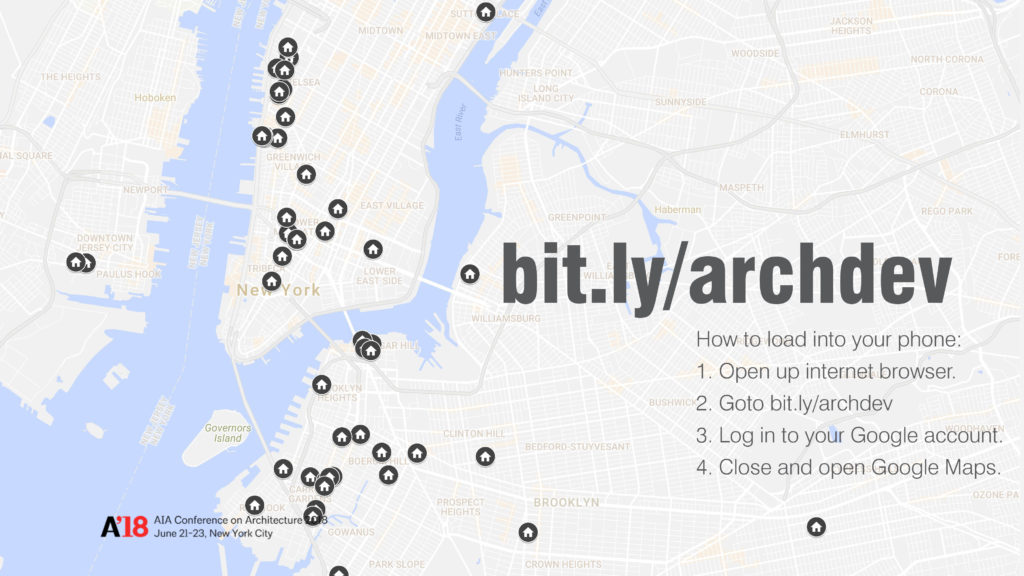
For the conference, I have put together an interactive map. Go to bit.ly/archdev from your phone browser and this will load into your Google Maps app. This will show you a lot of the projects around New York City that have been developed by architects. There are actually a lot. If you are walking down the High Line, you would be really surprised to look left and right and see projects that have been developed by these guys as well as others. On that note, let’s start with Mr. Alex Barrett.
Alex Barrett – Barrett Design
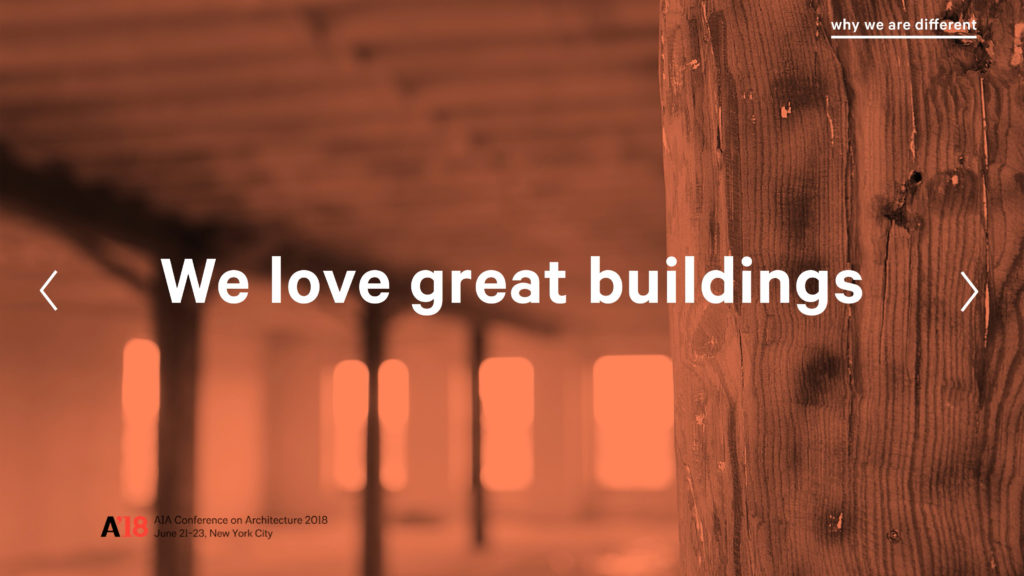
It’s a privilege to be here and especially to share the stage with Jared and Peter. Barrett Design has been around for 13 years. I started it with the premise that combining architecture and real estate development will improve both. It is our belief that designer-led real estate development is more thoughtful, more meaningful, and ultimately creates more value. At the same time, it is our belief that architects who sit in the owner’s seat are more effective, more disciplined as designers, and ultimately more profitable if all goes well. At this point, my firm is a team of seven. We have six architects and an office manager. We approach each of our projects as designers first. We seek to create the best buildings that we can within the many constraints that we are faced with, but also guided by a core set of values.
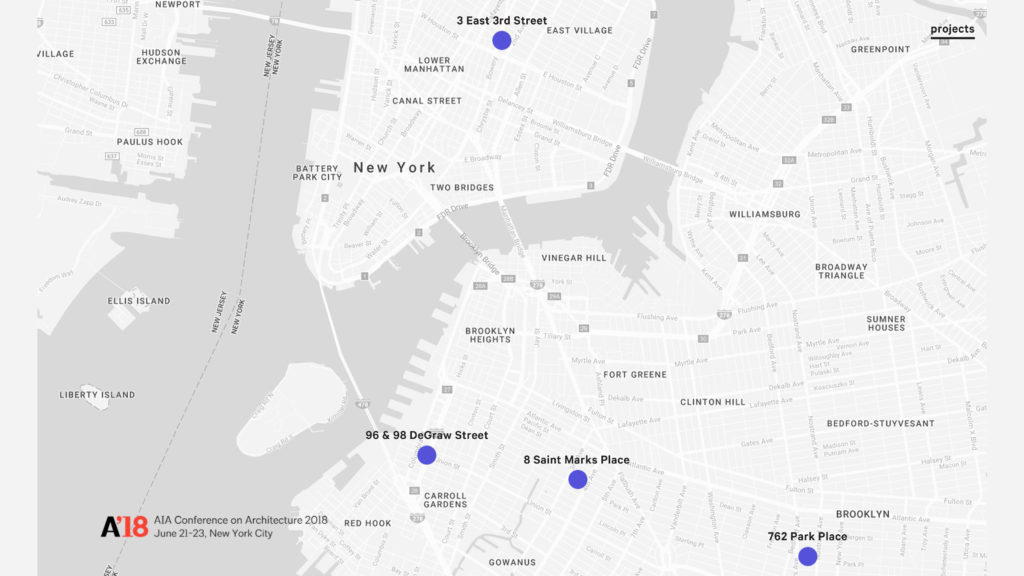
To date, we have finished eleven speculative development projects. Mostly in Brooklyn, but we just started one in Manhattan. We have four projects under construction at the moment ranging to as few as two-units to as many as twenty-three units.

James asked us to speak a little bit about how we structure our projects. Our project structure, at least from a capital standpoint has been pretty consistent over the past 13 years. We identify a project that has some sort of untapped and uncreative value that we can create through design. We raise equity from investors. At this point, all of our equity is raised from individual investors. We haven’t used institutional equity which I believe is a departure from my fellow panelists. We raise debt from construction lenders as well, and I think James will talk a little more about that kind of typical capital stack. The process of finding projects is the hardest thing for us. I wish I had a good answer for how we do it, but it’s really by hook and by crook. Brokers are involved in a lot of transactions.

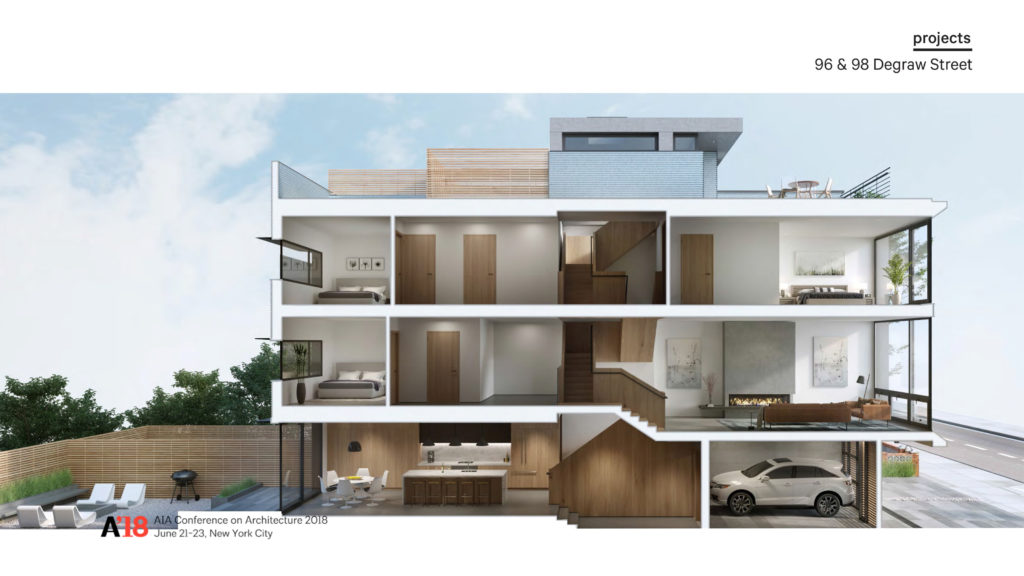
Most of our projects have been condominiums, but this is a departure for us. This is two single-family townhomes in the Columbia waterfront district in Brooklyn. Our first project in Manhattan is about a third of the way through construction right now. It’s just off the intersection of East Third Street and Bowery. Not far from here [The New School]. It will be a six-unit condominium at about 20,000 square feet with retail space on the ground floor.
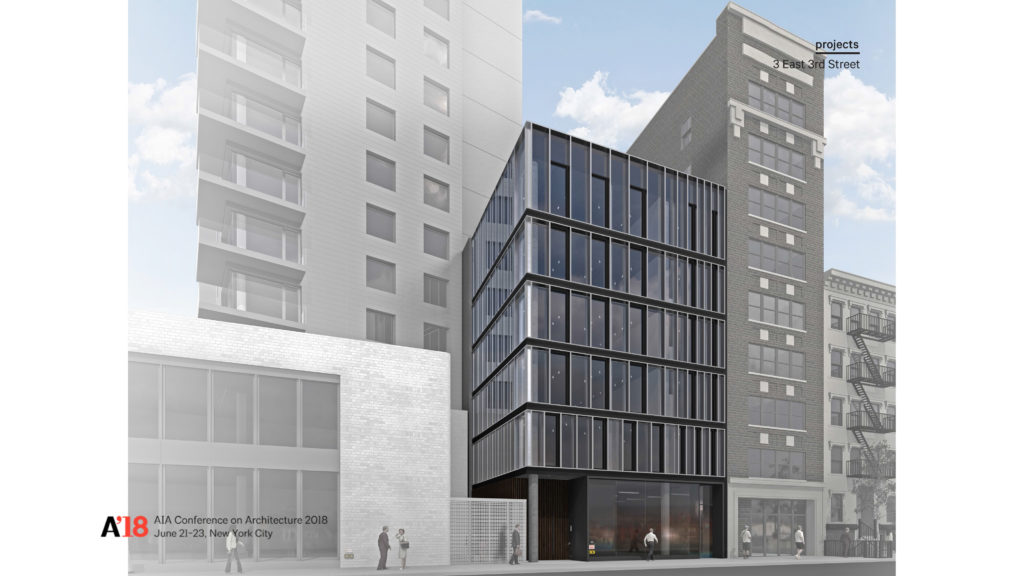
Jared Della Valle – Alloy
Good morning everyone. I’m Jared Della Valle, the CEO of Alloy. Alloy is a real estate development company. Twelve years ago, I had to say that I quit architecture. It required a little bit of therapy to go there after growing up and going to architecture school and always imagining that was the outcome. I felt like when I said I was an architect doing development, people didn’t understand what that meant. They thought it was the lite version. When I said I was a developer, people understood it, but people thought that I was evil and that I had genuinely quit and didn’t care. So it was a confusing dilemma that we face. An identity crisis is what we call it. We’re sort of like a platypus.

Alloy is a real estate development company. It was funny watching Alex’s slides. I feel like each of us could give each other’s lecture, certainly the beginning part. We distort the use of the word “value” in our practice. As architects, we grow up. We all feel the social contract, the moral obligations, the production of great work in our city, and we believe that architects as developers can make better choices. We can distort the use of the word “value.” In our practice, value is not about economics, it is about great architecture first.Our company is very strange. We are actually six companies. I shutter to show our corporate tree. I thought about it for a minute. I thought that this is the AIA, and that they may not like it. We are a development company, that is the holding company. We have a design, LLP. We have a real estate brokerage company. We have a construction company. We have a management company. And we have a community development company. We kind of do whatever it takes. We joke, “OK, Alloy TV/VCR Repair.” Typically we find that we can solve the problems better than the industry can.

So this came early on in my career where I recognized that developers need us early on in the process and they need us until the end. But we extract very little value from the time commitment and the from the value creation over time. Perhaps acquisition and project conceptualization, the development of program, might not come from the architect. Sometimes it does. Ultimately, the management doesn’t. But we still get the phone calls, don’t we? In the end when something goes wrong and it’s two years later. And we answer. We get nothing for it.

So over the last twelve years, we too have only acquired eleven projects. You’re starting to see a theme here. We only work on one thing at a time. We have no clients. We work for no one other than ourselves. We provide no services other than to ourselves. It keeps you focused on what it is that we are doing and how to manage time and prioritize the development process. Right now only one project is active. As of the other day, we acquired another one. It is sort of rare. We think about our work a little bit differently. Our office certainly functions differently. I will get into that a little bit.
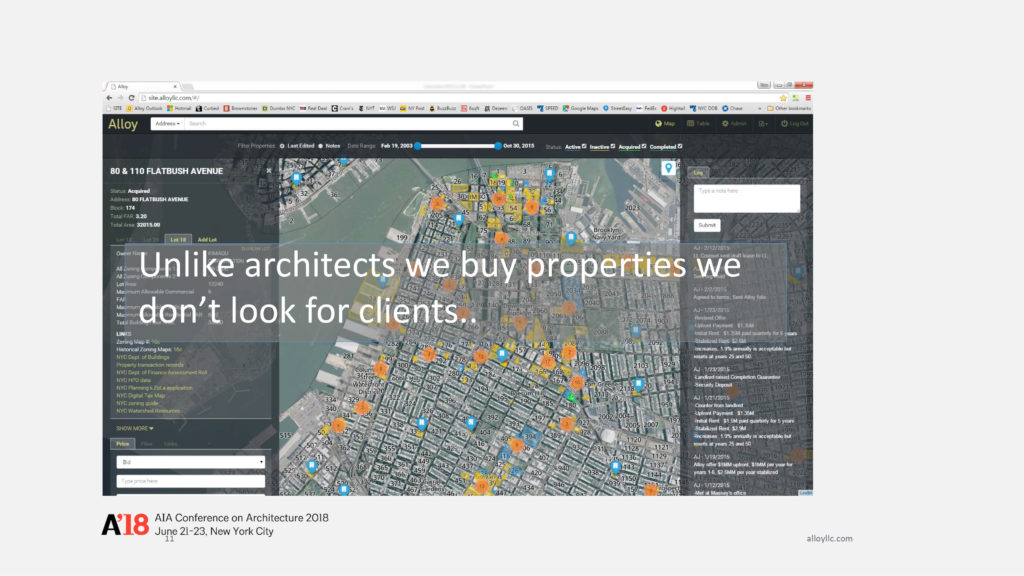
Unlike architects, we buy properties. We don’t go looking for clients. There is a big difference. We invest the process of how we go about acquisition differently. Here you are seeing a piece of software that we developed. It is a map-based communication tool that we use in our office to identify what we have looked at in the past, associate news affiliated with different properties, connect to all of the zoning data and property transaction records that exist in the city. Even more than that, it is sort of like a dashboard in our office that helps us identify who we have spoken to in the past and enables us to see information in a different way.

This idea came to me in graduate school. This was my graduate school thesis. I had this idea for an architect-led development company that was also a contractor. I was recognizing that this is a broken industry. This is my timeline of how this went for me. I will get into a little bit about how our office works as well.
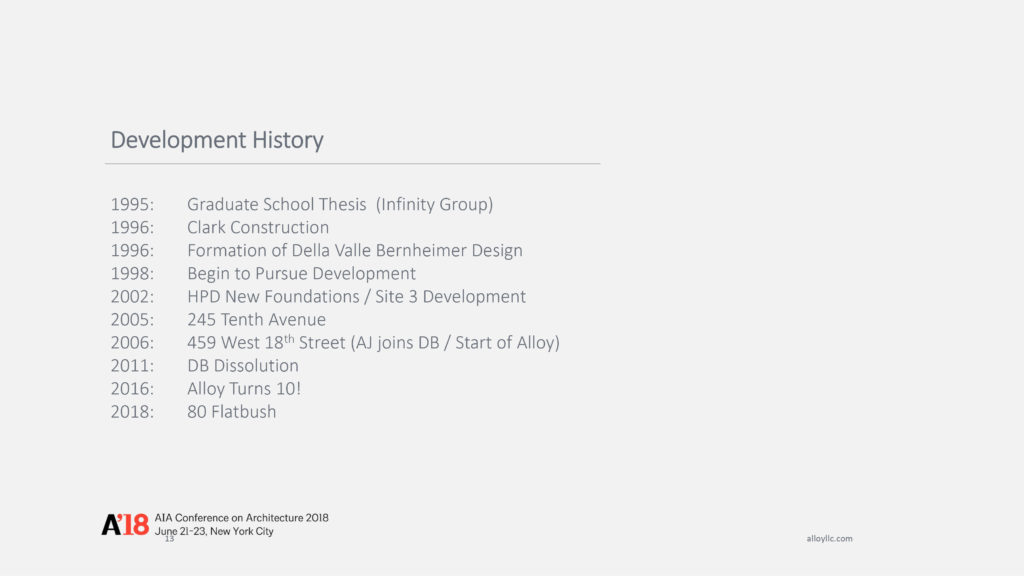
So it was my graduate school thesis in ‘95. When I graduated from school, I graduated with both a Master of Architecture and a Master of Construction Management. I kind of didn’t want to be told that I couldn’t do something, but rather that I could learn how to actually build here in the city. So I worked at a construction company for five years. While I was at the construction company, we won a design competition with my former roommate from graduate school for a federal plaza project for the GSA in San Francisco. In ‘98, we had taken on our first job. I was twenty-four years old and I became incredibly frustrated with the process of how we go about getting clients so I started to pursue development and tried to acquire sites as a way to build work for the practice.
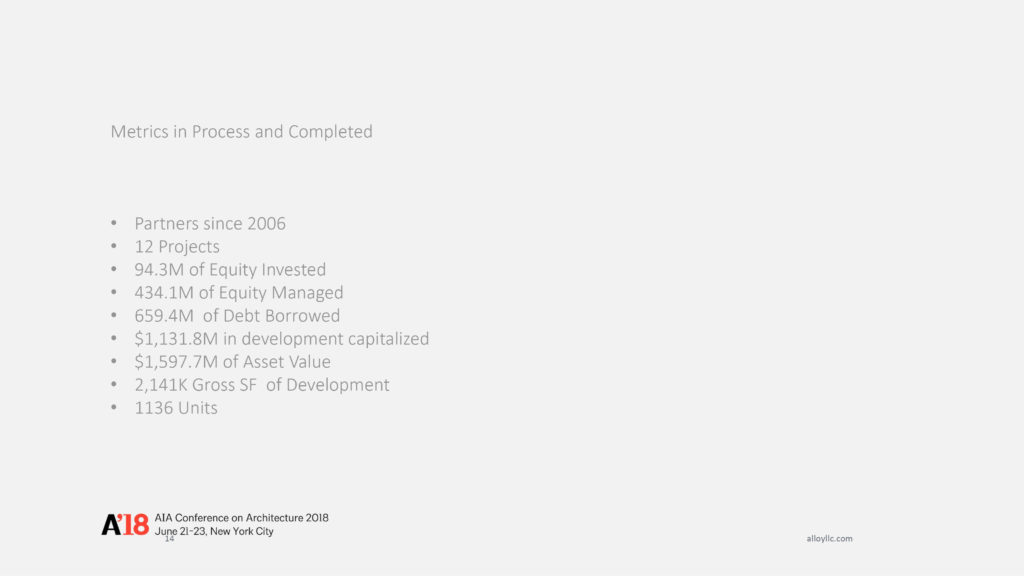
Our first project as a developer, we won an RFP [Request for Proposal] in the City of New York for affordable housing. I then helped someone else acquire property. Then acquired my own property at 459 West 18th Street. In 2011, we dissolved the architecture practice formally, and I had already started Alloy already in 2006. So in 2016, Alloy had turned ten, and now we are working on a project that is a little over a million square feet. So we’ve been partners since 2006. We have worked on twelve projects. We have invested around $110 million of our own capital. We have managed about $430 million of equity. We borrow a lot of money. That is one of the big differences between architects and developers. It’s hard to borrow money as an architect. We are now approaching 2 million square feet of development at over 1100 units.
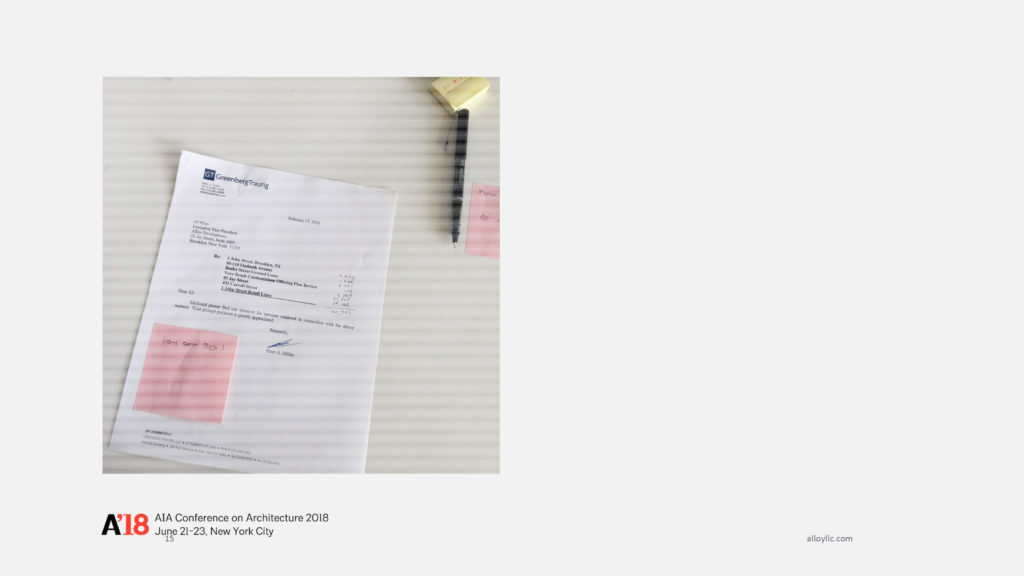
One of the big differences between our practice and an architecture practice is that we take a lot of risk. This is a note by business partners that one of my business partners left me with one of my legal bills that says, “holy shit pies” on it. We are spending about $120,000 per month on legal fees to manage the opportunities and to rely on different consultants on doing the things that we do. We things about things a little bit differently. This is a change order signed by me as the owner, signed by me as the architect, and signed by me as the contractor. We run our practice a little bit differently. Somehow our bank requires this formalization of the process that our industry has already defined. It’s the way we go about things. We kind of play by the rules, but don’t.
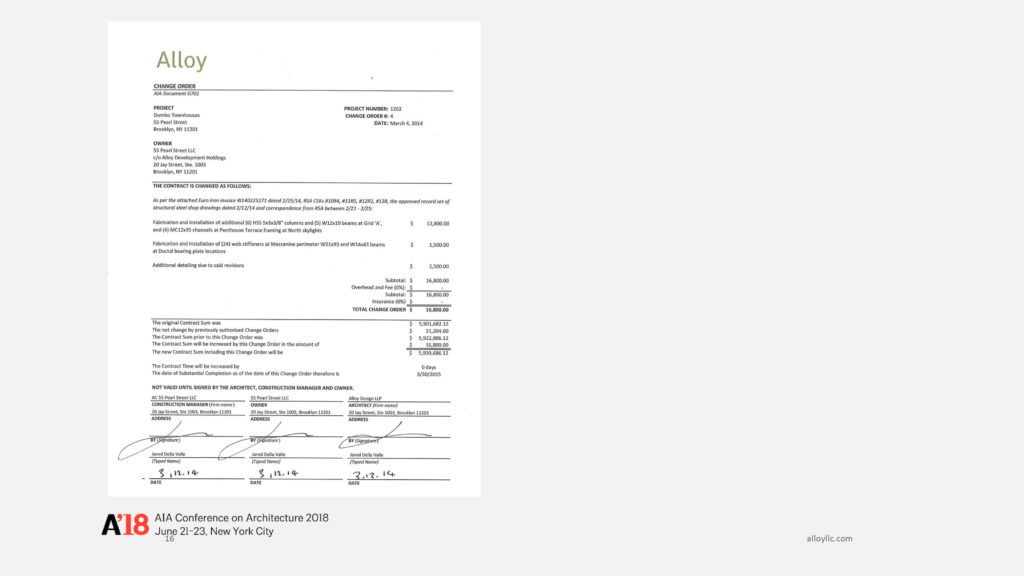
There are four partners. We have eleven employees and two admin, which makes 17 in total. We think of ourselves as more like 34 people though. Everyone in our office is like a swiss army knife. We are working on one project at once. You might be involved in marketing one day, you might be involved in construction another day, you might be involved in acquisition another day. There is only one person in our office that has real estate training. We are all architects. We have this incredible capacity and the economics are not rocket science. How much does something cost? How much is it worth at the end? We have run our practice that way.
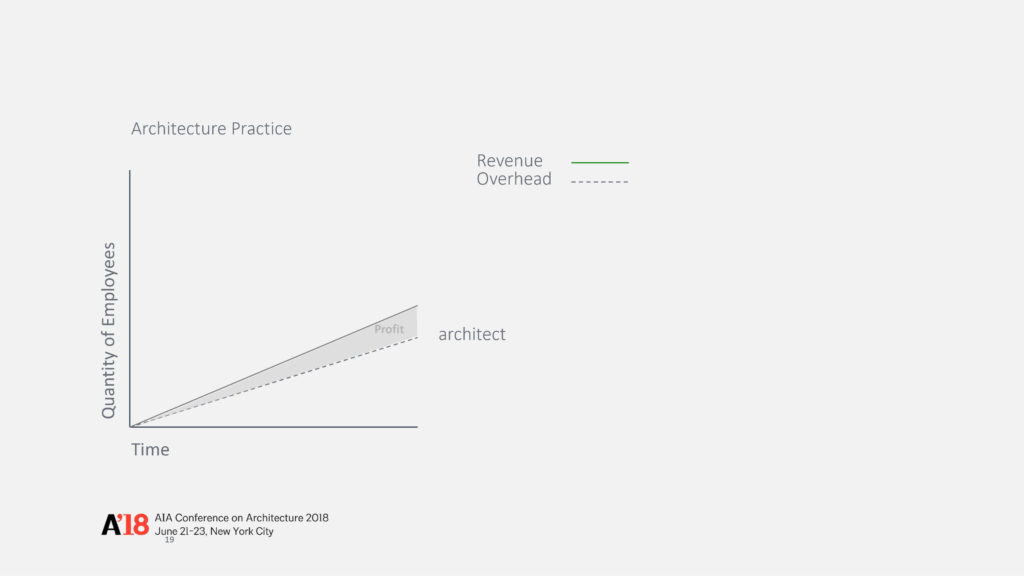
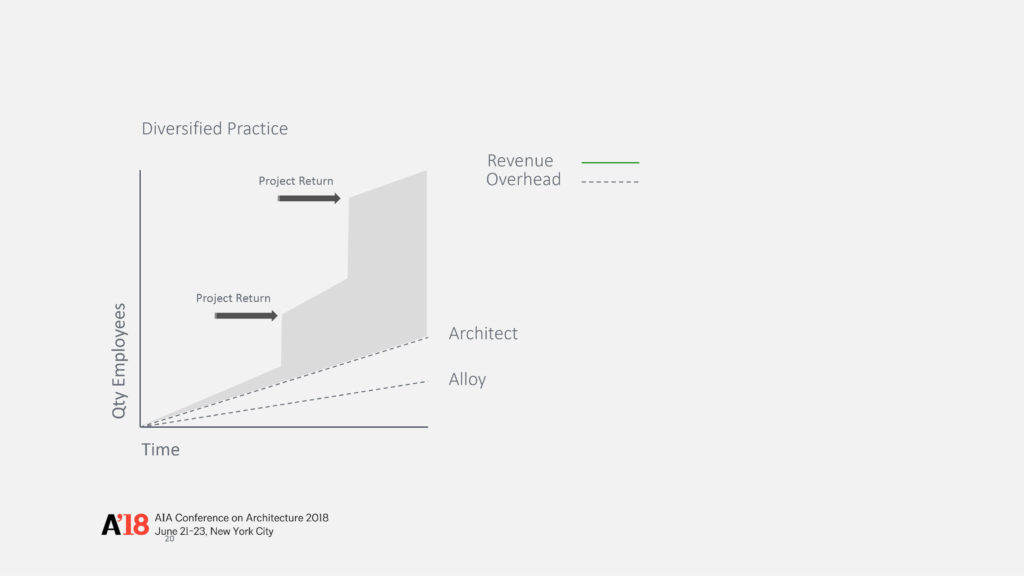
Eight of our employees are licensed architects. It’s been like a gateway drug for people. Once you are here, you can’t imagine unscrambling a scrambled egg and just providing service. So the typical architecture practice works off a pyramid right? You have employees, and you make money off of those employees. The more employees you have, the more theoretical revenue you can make. With a development company, we have that too right? We have something that we call “Money Day” in the office. My partner sends me a bill, and I pay it. We do that for architecture services, for development services, and for brokerage services. But more than that, we actually get the value out of the real estate. So we have these moments where at the end of the project, there is meaningful value there that we have created and achieved that’s different right? We have a project return.

So how does it go for us? This is a typical project that we are working on now. A hundred million dollars is the type of project size that we like. So this is a general sense of how this works for someone like us. We pay ourselves architecture fees, construction fees (including general conditions and other things for our own construction company), brokerage fees (for doing the sales). Nobody is better at sales than an architect, I promise you. There is no broker who can outsell one of us. And developer fees. We pay ourselves developer fees every month. We get a developer draw. And keep in mind, that I am billing the same employees for the same tasks multiple times at the same time. At the same time, we get project profits. On one hand, we are taking all of this risk and it seems a little bit crazy, but if you add all of those numbers up, remarkably, I have created a hedge for risk. The market can go down quite a bit, but if I only make my fees, we have still done well, right? So I have protected myself market-wise by taking on all of these roles and ironically taking risk.
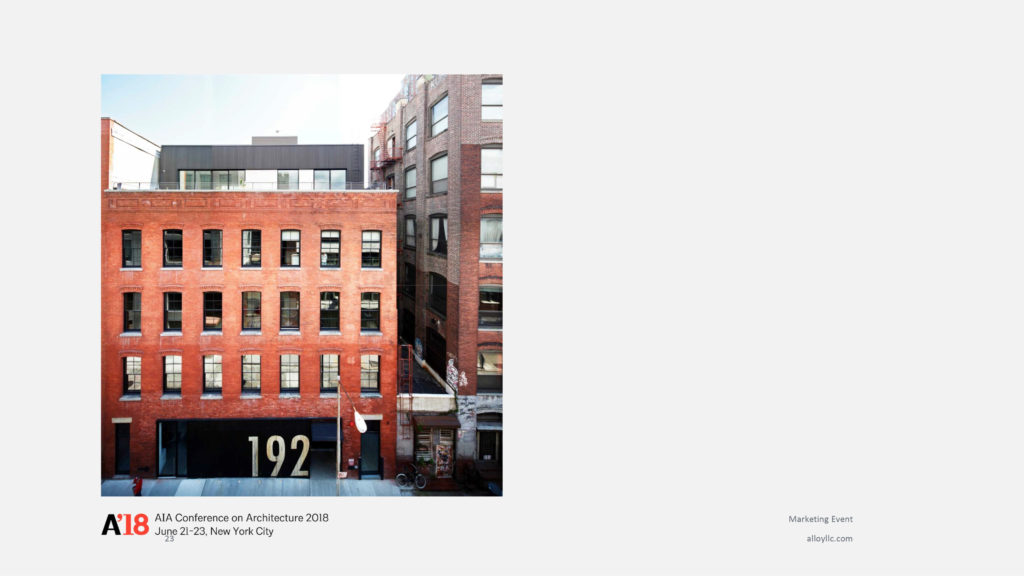
So we do things a little bit differently, and I will talk through a couple of projects really quickly. One of the beauties of being the Architect & Developer is controlling the message. This is a project we did in 2009. When the world was falling apart, we bought a small loft. We had a modest budget for the project. It was a 30,000 square foot project. We had a loft building. We bought a beautiful building. We had actually tried to buy it a few years earlier, and that buyer fell apart, so we bought it from the bank.
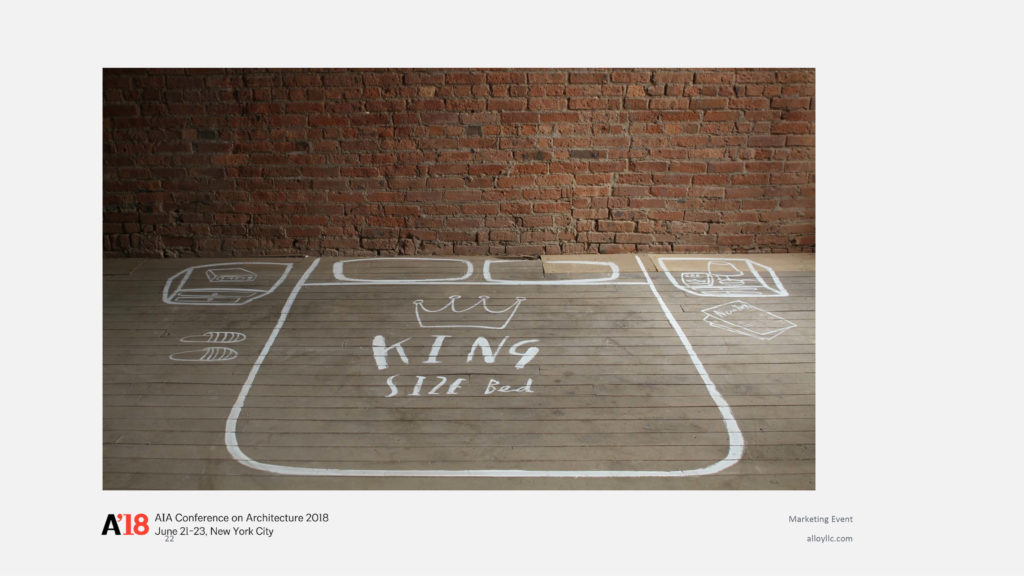
Then we hired a children’s book illustrator to come in. We gave him $2,000 and a can of white paint. And he literally painted the floor plans all over the whole building. That night we sold $21 million in real estate. We had one apartment left at the end of the night. It was a super scrappy way to talk about space in an existing building. It was a simple renovation in a historic district. It was one of our favorite projects in a way. It showed a re-thinking. Had we dealt with a broker, they would have said, “Well, you need a marketing brochure, you need a book, you need floor-plans, you need all this stuff.” We were like, “Nahhh, we’re not going to do that.”
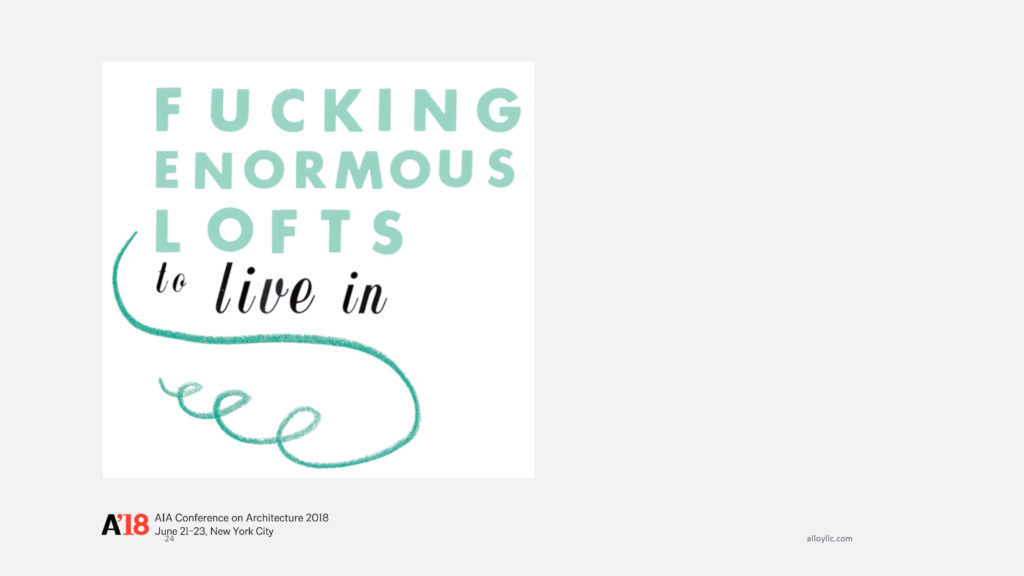
So sometimes we get carried away. We recognized that we had a lot of demand for that type of product. So the next building we bought, we brought the children’s book illustrator again. He rode off on his scooter and said, “I got it! This is the perfect idea.” So he came back with this. We were like, “Huh. Maybe we’re going too far? Maybe we need to edit.” So we do have some editing capacity in controlling of the message and the idea. In this instance, we were selling space in New York City. These were large spaces with 3-thousand square foot apartments with 14-foot ceilings. We were trying to connect people to the idea of space being the most important thing. So there are projects like that.
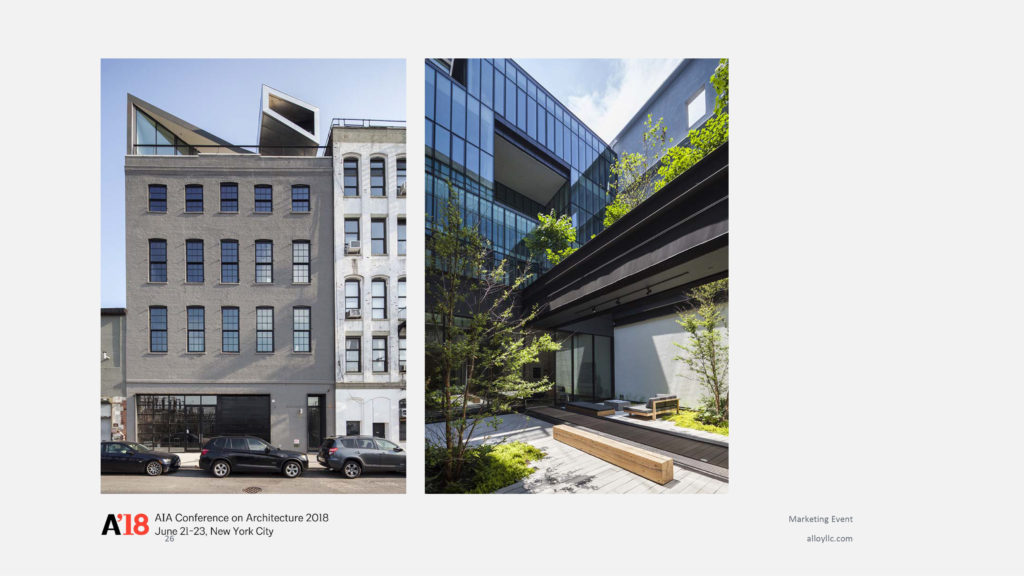
This is a 35,000 square foot project where we are doing these big apartments, and making these big decisions, some of which I might not make again. In the image on the right, we had a block through building. We cored out the middle of the building and repositioned the bulk on top of that building, which is the image on the left. It is in a landmarked district, which adds complexity when you are taking apart a building that was built in the 1880’s. Again, another successful campaign. We sold out in two-weeks with this information with just an existing building and some very simple collateral.
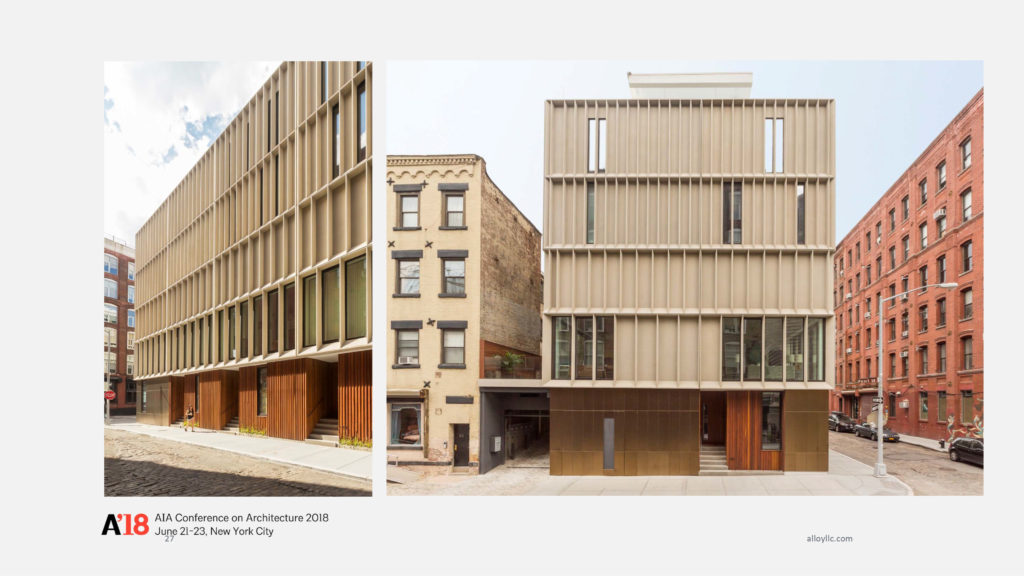
Over time, our projects have largely been in a single neighborhood, literally a block from my office. We can’t tell if that’s just because we’re building a reputation there and sellers are coming to us, or because we’re lazy. But this is a project we built in our neighborhood, a block from our office. It started our construction company. These are some of the first passive townhouses ever built in Brooklyn. They have a ductile concrete facade. I think taking risks like that, where we think about the history of this neighborhood, which had some of the first reinforced concrete buildings, built in the early 1920s by Robert Gair… pre-Brooklyn Bridge. We took this idea of reinforced concrete and pushed it to its limits with a product like ductile and created a new townhouse typology that looks more industrial. We took the risks on the aesthetic choice and prioritized where we would put value and how those would fit in with an existing neighborhood. Again, how we would think through delivering a product that was unique to the neighborhood by delivering something that was on the edge for sustainability purposes.

So, this is a joke, but not a joke. We started to get involved in these Public-Private-Partnerships. We were awarded a site through a public RFP in Brooklyn Bridge Park. We started to really enjoy the early part of sales and marketing. We were trying to figure out what we were trying to do here. We were building inside of a public park, so we decided to build a park in our site, while the park was in construction around us. So we planted a big field of flowers. In the end, we were like, “Well we have to take this down before we start construction. How are we going to do that?” So someone in our office was like, “We need goats.” I go home that night and my wife was like, “What did you do today?” I was like, “Well, I had to find a shepherd to sleep in the field with some goats, so that the goats wouldn’t get stolen overnight.” So we planted this field of flowers, we brought in some goats, I found somebody to sleep in the field with the goats. Unfortunately, one of the goats broke free and started running through the neighborhood. So not everything goes according to plan. It enabled us to create something that was memorable in the neighborhood. This idea that place and working in a public park was a privilege and trying to connect that to a place that had no address. It was in Brooklyn Bridge Park, so we called in the John Street Pasture.
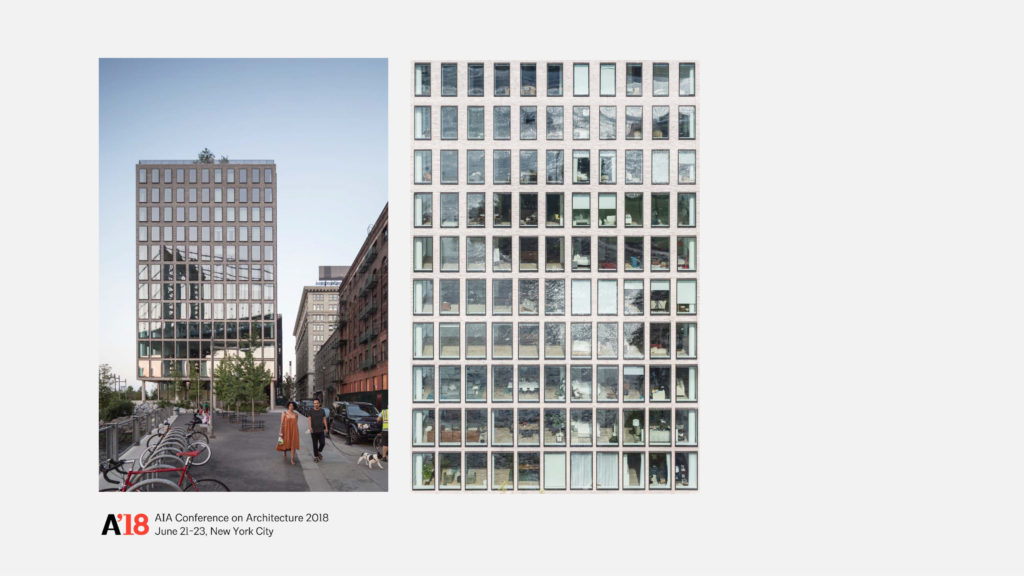
The building itself, we start to jump scale as a practice. This is 130,000 square foot building. We understand the sort of historic context of this neighborhood and the typical relationship of window typology. In this neighborhood, because you are on the river, the views down low are actually better underneath the bridge. So we pulled all of the windows forward and proud of the building. We inverted the typical relationship where the windows get smaller at the top. It starts to create this sort of double-take, where it feels like it’s part of the Landmark District. We built a really beautiful brick building. The bricks actually get smaller as they go to the top as well. It changes the nature of the reflection to a clean reflection with a broken plane rather than recessed windows which is common in the neighborhood. This started our Public-Private-Partnership model. We donated a space to the Brooklyn Children’s Museum in this. I always joked with my partner that it would be faster for us to donate a museum than it would be to get called by someone to design one. So we are starting to do that.
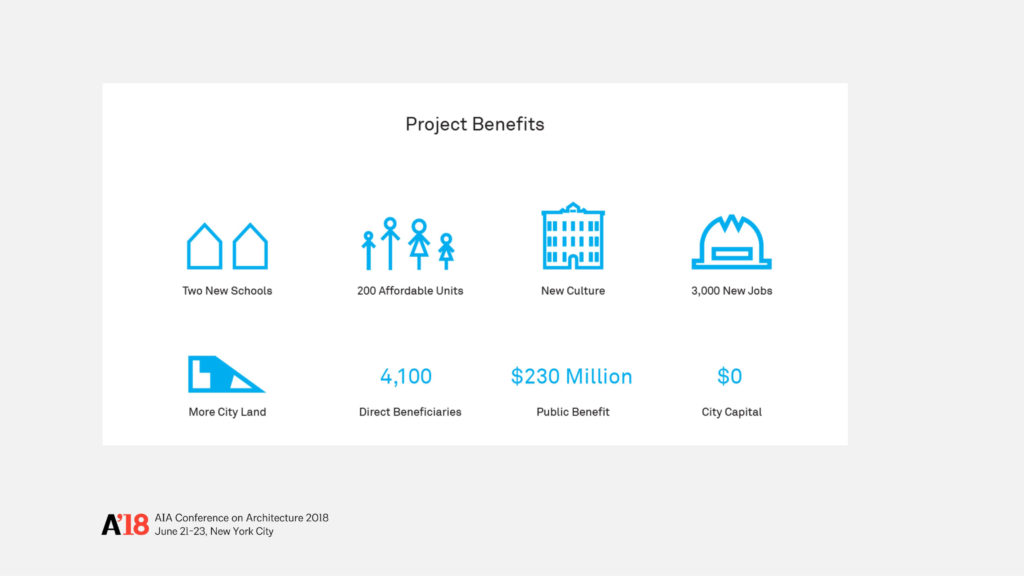
Community engagement has become a really important part of our practice. We don’t spend money on marketing. We spend them on the communities in which we are working. We are working on a large project now in downtown Brooklyn that is going through public review process. It is over 1 million square feet. During the process of development and while we are pursuing entitlement, we have sponsored six projects. We spent over $1 million on early public engagement. We have done everything from creating a system for court-involved youth to get diverted out of the court system through arts education. We donated a space to non-for-profits and dance and art organizations. We created community festivals. It is about this idea of building awareness in the communities in which we work to connect to people, the places we make. We are making real estate, and we are selling it, but the places we make, we want them to be valuable. We want them to have this alternative sense of value where communities can be proud of participating in them. And proud of having them as their neighbor. So the project we are working on now has a series of features which we are starting to really leverage for density for scale. On this new project, we are donating two public schools with over 700 school seats. We are creating over 200 affordable housing units. We are donating one of the existing buildings to a cultural institution. It will be over 15,000 square feet. We are creating over 3,000 jobs with that. We are swapping our property with the city for more land so that the schools can have large open-space features like gymnasiums and auditoriums which they currently don’t have. The cost of this benefit for the new project is over $230 million in public benefit, for zero dollars to the city.

Projects like this are what we are working on, which is a 980-foot tall building with another phase that is 500 feet tall. It sort of expresses to me what our role is as an architect. We think of an architect in a traditional way where we are providing services for people. But, ironically the further I get from providing architectural services, the closer I am to being an architect. The definition that is shown here, “The person who is responsible for inventing or realizing a particular idea or project” is how I perceive our practice.
Peter Guthrie – DDG
Well done, that’s a tough act to follow. I am Peter Guthrie of DDG. We started DDG in 2008 and been going ever since. We do a lot of the same things that Alex and Jared are doing. We could probably give each other’s lectures. It might be a fun thing. We will try it out the next time. We design-develop-finance-construct and then manage our projects. We are vertically integrated and this is a horizontal slide. We are doing a lot. We are building in New York, San Francisco, and Florida. We are also looking at a project in LA right now.
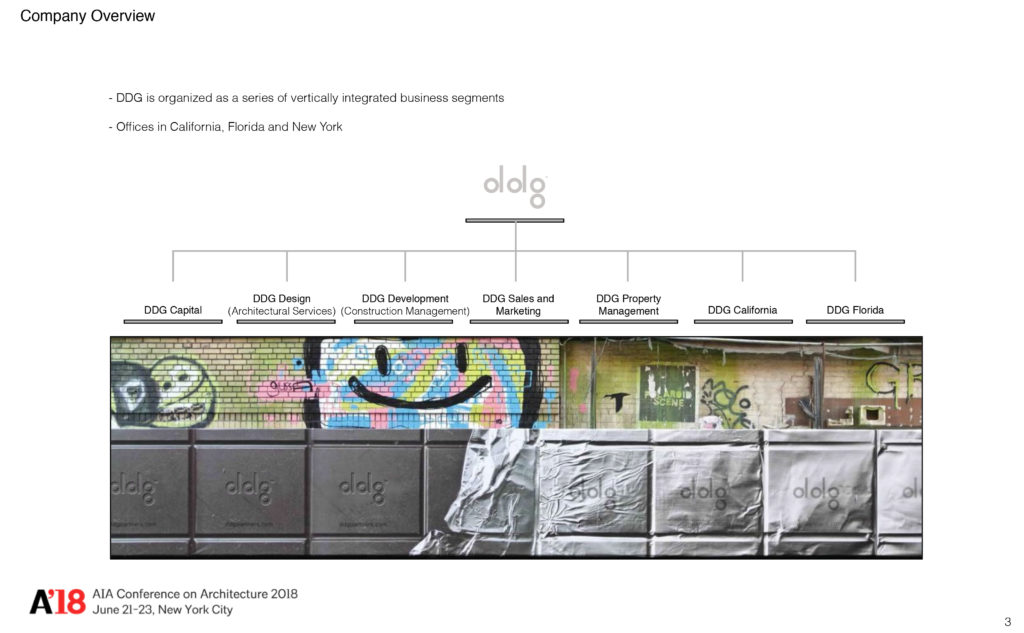
I studied art history and sculpture, and then went and took a Masters in Architecture. I came to the city and I did a number of things, but I was always interested in making and building. My passion is that. It is at my core. I came to the city and worked for a metal worker in DUMBO. So I know your area very well, Jared. That was super fun working for $10 per hour shaving welds. That then led to a job with Peter Gluck with GLUCK+ Architects. For those that don’t know who he is, he is a great mentor. I learned the design-build philosophy from him. I had done what I would consider design-build work. At Yale, we build a house for folks in the neighborhood as part of our first year building project. It was a great way to see a building through. I had also worked for Habitat for Humanity while I was at Duke. I think I added in my bones that you could really make a difference by getting out in the community. That was at least the difference that I wanted to make. I wanted to get out there and figure out how to get something done. When I moved to Brooklyn after working with Peter for a while and wanting to do my own thing, I, like Jared, did some work. I built a house for a friend. Then I had that same sort of feeling of dread of beating the pavement looking for a client.

So I was looking around these buildings in Brooklyn with Fedders air conditioner units in the windows and thinking, “What are these guys doing? What is the secret? How could we do a development project?” I was talking to some guys in the neighborhood and it came down to something that certainly wasn’t rocket science. “300! 300! 300!” I was like, “What’s that?” “You buy it for $300, you build it for $300, and you make $300.” And it’s that dumb and that simple. The pro forma was a back of napkin idea. You buy it for X. You build it for Y, and you sell it for Z. Hopefully, you have done your math correctly. I had done that already on a very small scale. I built a desk. I bought the wood myself. I could break it down, and I think all of you guys, those of you that have studied architecture, have a great skillset to break problems down into very simple components and not get overwhelmed.

This complex thing that is blurry… and I hope you can’t see it specifically… because it may be confidential… it has a series of parameters. I have a slide later on which I love. It is my grasshopper script slide, which is parametric design thing. We use it. It’s fun. It’s essentially the same thing. Architecture, and many things in life are a set of parameters. What you do those parameters and all these little toggles are related to time and money. Lurking beneath all those numbers are choices. There are a myriad of choices that you can make. That is the fun of it for me. Every day, I wake up thinking of the opportunities that are going to be on that day. In talking to a banker, talking to an electrician, talking to one of our architects, talking to one of our construction managers, talking to one of our building managers.
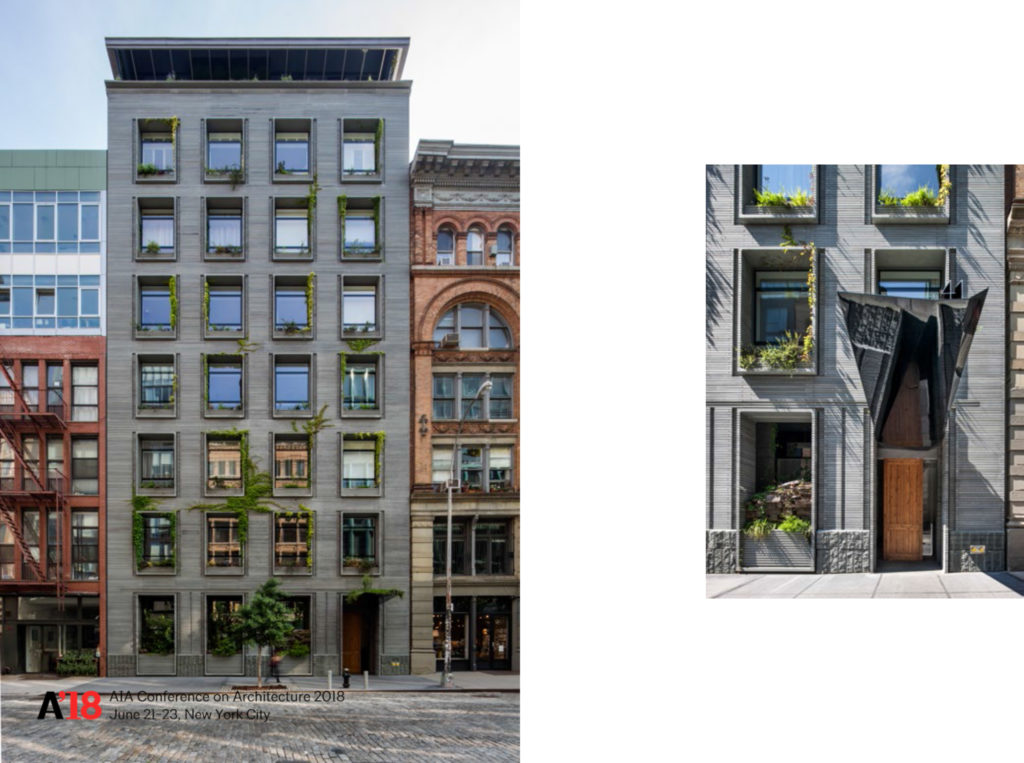
So this is our first project in Manhattan. It’s 41 Bond Street. It is a bluestone building. It is in a Landmark District, so we had to come up with a way to make a ground-up residential building in this Landmark District with the auspicious start of being right across the street from Herzog and de Meuron, and my old professor Deborah Berke. It was just not where I wanted to start. I go to the site and I see school groups coming through and they’re all oogling at Herzog and de Meuron. I love their practice. I know there are money people who don’t love that building, but I do. I love that building. It is something that I could never make. We knew we had to do something different. We needed to be chilled out and respectful to this neighborhood and try not to draw too much attention to ourselves. So we buckled down and found a material, this bluestone. We had done a building down in TriBeca already, so I already had my feet under me. It was still standing, so we thought we could keep going. What we did was take craftsman… and one of the secret little weapons we found in the numbers is the labor. I agree with Jared. Unfortunately, on this project we are working on right now in the Upper East Side, we have become the concrete contractor. I didn’t get into it to want to control every little piece. But you do find that it is to your advantage. So we have our own masons. We bought the stone and we shipped it down and we would cut it and carve it on site. Not radical craftsmanship, but just a step that is really hard to get in the direct marketplace if you don’t have direct labor. It is a rigged thing. By having direct labor, we can pass that profit on to the project itself. We are not taking that profit and putting it into our pocket. We are putting that profit into the project.

That is Mickey over there on the right putting that door frame in. We did everything on that project from soup to nuts. From the facade, we put in all the windows and all the interior framing. All the bathrooms, and all of the trim. All of the specialty trades. This is a team that I had built up over the previous 5 years before starting DDG. Again, getting into it from one guy who I hired as my grease, my general conditions, just to go around and help the other trades. We found that the other trades, like my door guy was not making it. He was just not getting the doors in and plumb. So I would ask Juan Carlos to go and fix it. Suddenly, there was somebody else we needed to bring on. We became, on the next project, the subcontractor. We did all the framing and all of the specialty trades. We got so tired of fixing other people’s work, and we were finding that we were training our own crew. That is a drawing on the wall. We like to break down the mystery… and I learned that from Peter Gluck a lot. We really labor over how to communicate, how to break down the barriers of this world of architecture and design and make it something that is more collaborative. We find that that interplay between all of these specialist or these artisans, our tradesmen, is essential. It results in a fantastic and unexpected interplay, where our details get better and better.
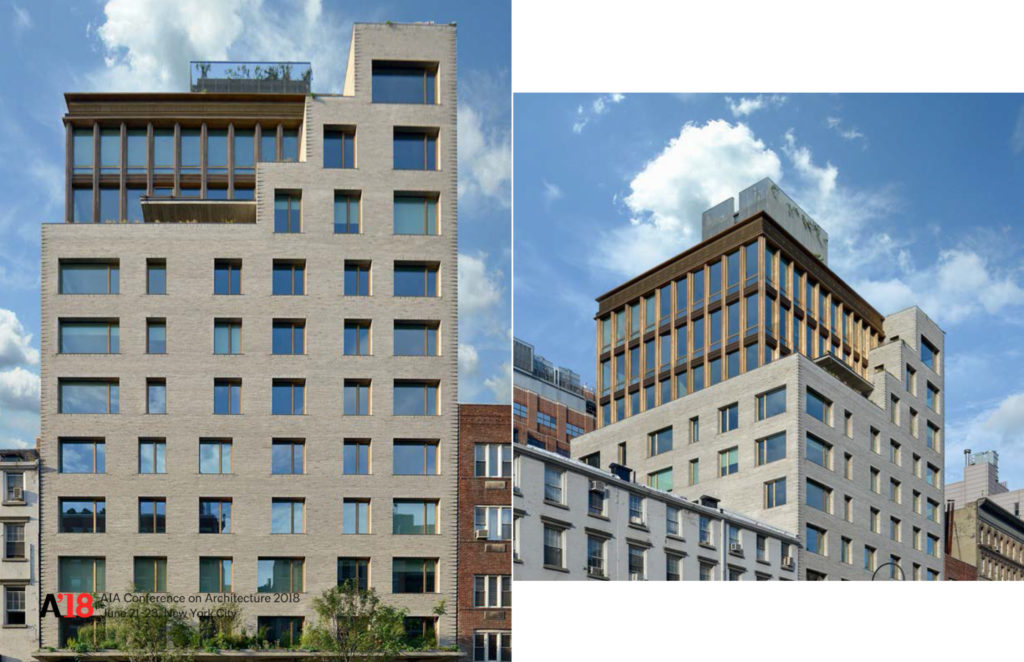
Jared is way ahead of me on this platform. You [Jared Della Valle] are really in an admiral place in terms of the community work that you are doing. We are just stepping into that field. This was a start for us, where we realized that there was something that was happening that was a little bigger than us. We could provide a platform. That platform could be synergistic and be win-win. We built a building in the Meatpacking District. We came up with an idea. I just asked a question. We had these mesh wraps that go around the scaffolding, a black mesh. What if we did something different? We could tie that to our marketing. Yeah ok. We could design something… in fact, we had already designed a sort of thumbprint thing. Then we asked another question. Who could we partner with? The Whitney was just moving downtown. Does anybody know anyone at the Whitney? My partner Joe did know somebody at the Whitney. So we talked to them and Kusama. They were having this great exhibition of Yayoi Kusama. It just so happened that the exhibition was coinciding with Louis Vuitton opening up 450 stores worldwide. We couldn’t have imagined a more incredible marketing boom to tie our building to the Whitney crossbreeding opportunity.
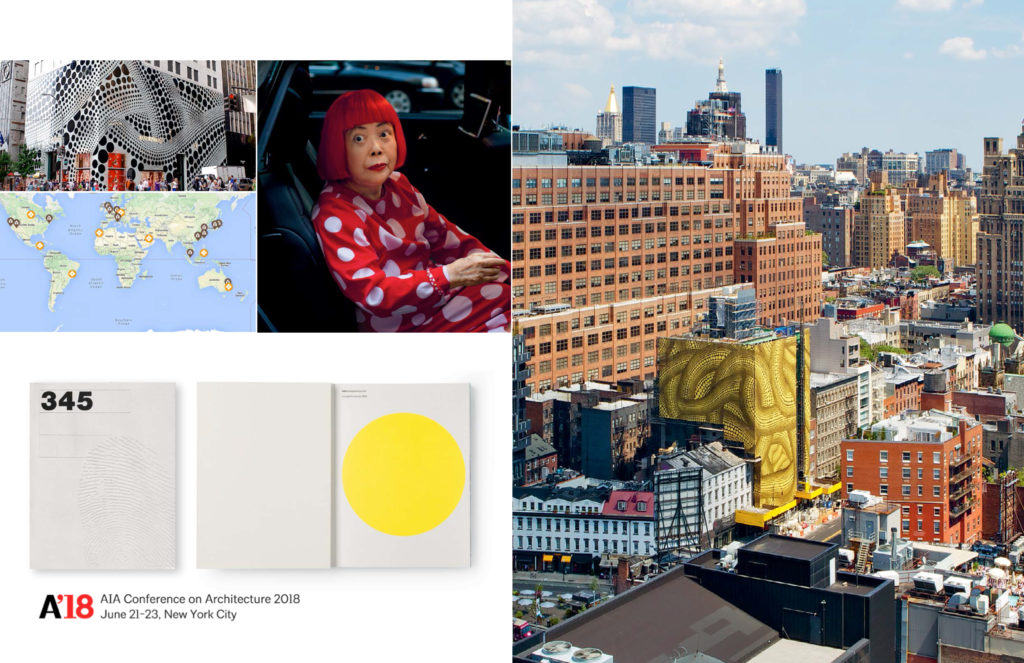
It turns out her studio was on 14th Street. Her dots sort of connects to the hallmark of this building, which are these bricks that you make. The guys making these bricks, and I have been over there to see the guys making them, as he is taking the mold out around the brick, leaves a little thumb depression in there. You can see it on the right. It is so sublime that you will never see it. It is buried in the wall. It is this incredible enigmatic touchstone of the human component of these handmade bricks that come from Denmark. To me, that little thumbprint connected to Kusama’s dots, which was this sort of invisibility shield.
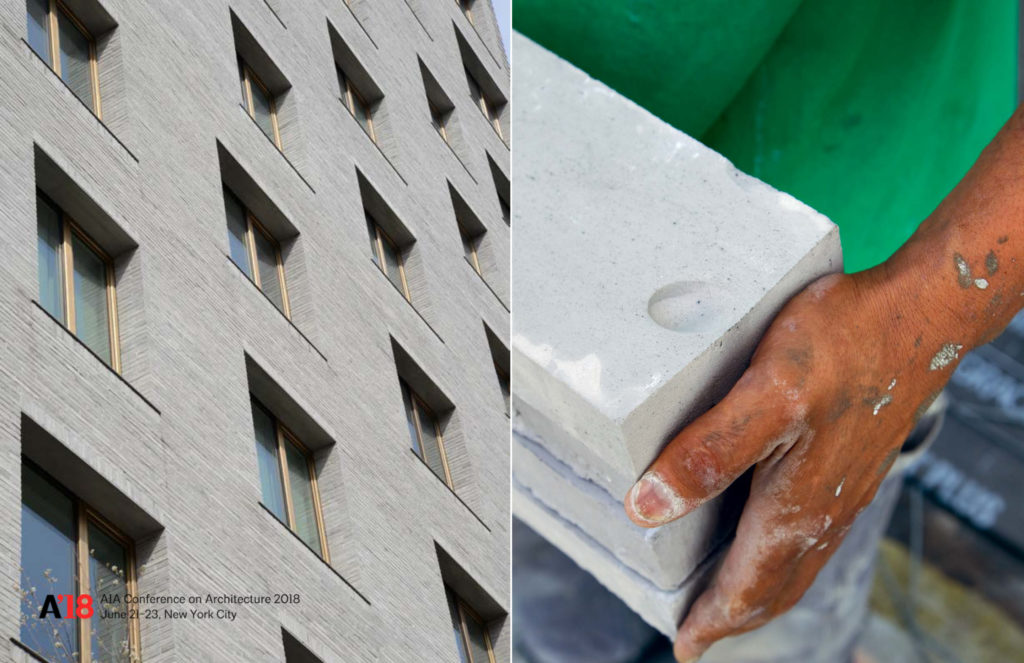
325. Some developers, not these guys [Alex Barrett and Jared Della Valle] will often look at this area as another one of these places to try and get around something. Oh, they’re smarter, they’re going to get under and around and play the system. We took a different tact. We said, “There are architects sitting in this room who are going to judge this project. What if this was a collaborative enterprise? What if this was like a crit back at school?” We went kind of overboard in making basswood models and looking at the tectonics. This building is in SoHo, so it is in the cast-iron district. We looked at the history of cast iron and component parts. We thought deeply about it. We entered into a discussion with Landmarks and showed them what eventually becomes a building… while trying to reinvent a language that is connecting to the cast-iron district.

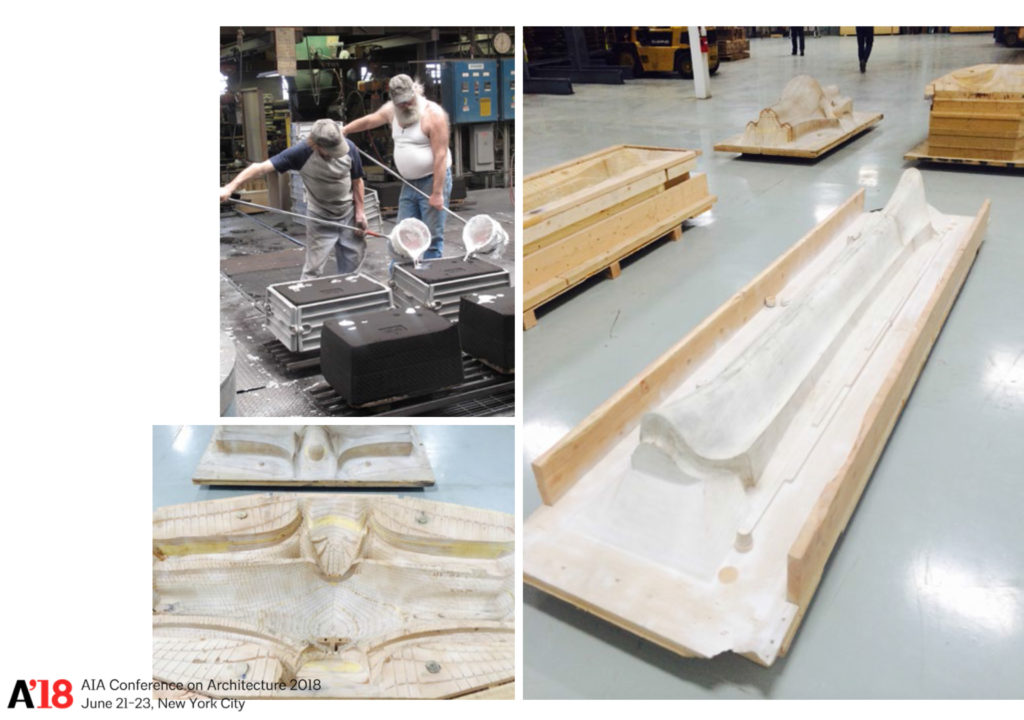
We end up working with the ZZ Top boys. They were awesome. They make chevy engine blocks in the middle of Pennsylvania. They were fantastic. They couldn’t believe that we wanted a weird burlap texture to our aluminum. We were gravitating to these pieces in a cart. They were the rejects. They were so used to military specs. This is us playing with the modeling and the finishes. This is the texture, a burlap finish. All of this craziness was supported by New York City Landmarks. It was a fantastic process. It was heavy. They had great feedback. We allowed the process to force us, but they were instrumental in making us try harder and made the details for architects in many ways. That was fun to realize. They really wanted to look at how the side of the building and our aluminum screen integrated. I thought, “Man, that is crazy. The Landmarks is totally having a modern architecture dialogue.” It was not what you would expect. The knee-jerk anti-modern rhetoric or stand that some people expect from Landmarks.
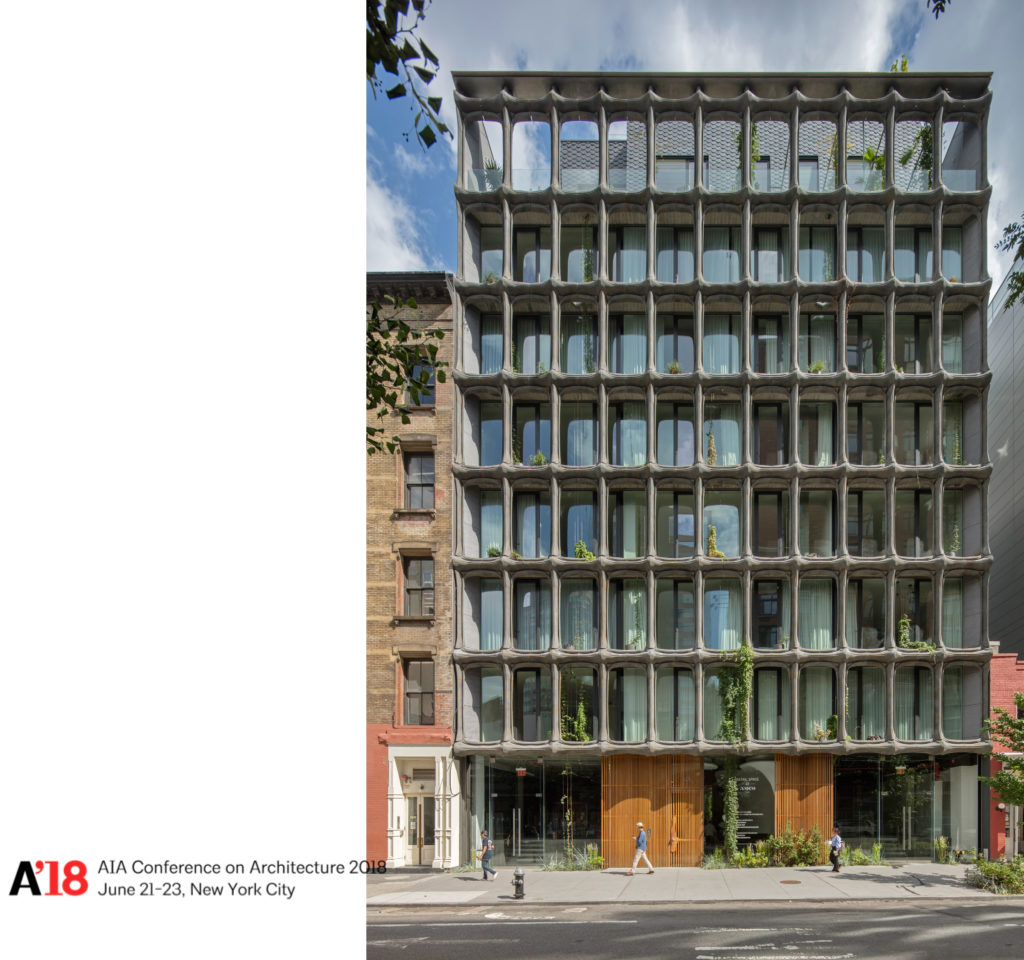
Our marketing… like the Kusama, we are partnering with Shawn Martinbrough, who had just given a TED talk. He is doing something the George Lucas now. He is a noir-comic-artist. He was instrumental in helping us find a story. Like what Jared was saying about creating opportunities outside of the traditional selling model, that was the thing that we learned form Kusama. In all of our projects, we do partner with other artists or artisans. We make books for them as well. They’re artworks in of themselves. We will do crazy things, like a billboard.

This is a story because this was an old chocolate factory. So we came up with a storyline of these two heroes who have to battle an evil robot. Ultimately they save the day by saving this chocolate recipe. I dunno. Somehow it made sense to us. Why not have a little bit of fun? It is tangential marketing. You will see this in luxury goods and Louis Vuitton and these Gucci places. Ferragamo had some illustrators do work. We are riding on that wave. I think that tangential marketing and the spirit of collaboration is what drives us. What I didn’t show earlier, is that the Kusama collaboration ended up influencing our grill design. So our HVAC grills in the apartments are this dot matrix that we would have never have thought about had we never partnered with her.
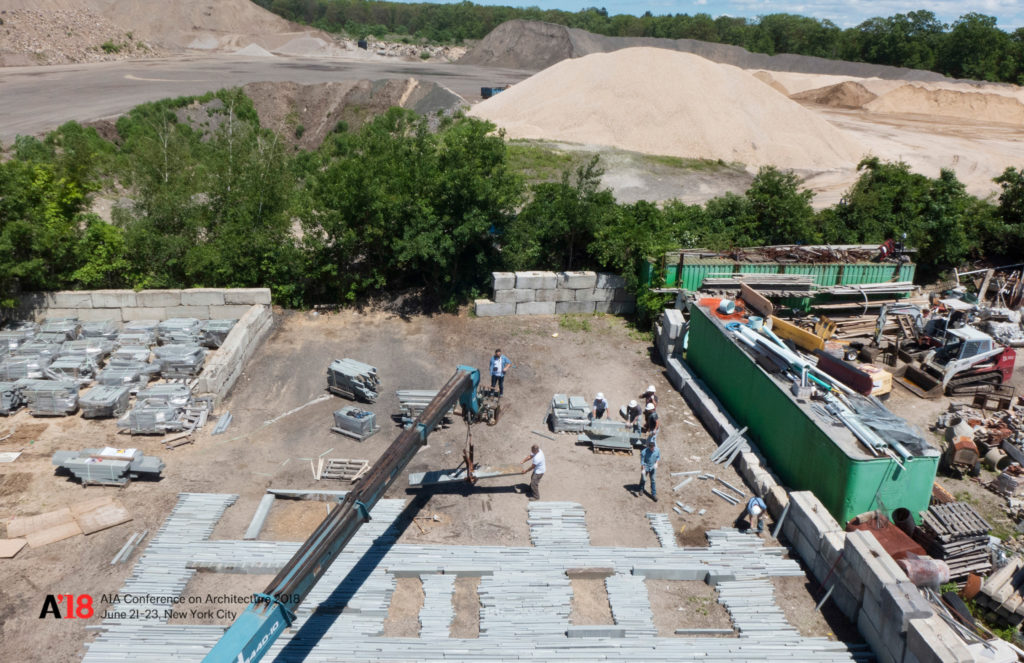

This is a building in TriBeCa. More bluestone. It was fun. We laid it out in a field in Long Island.
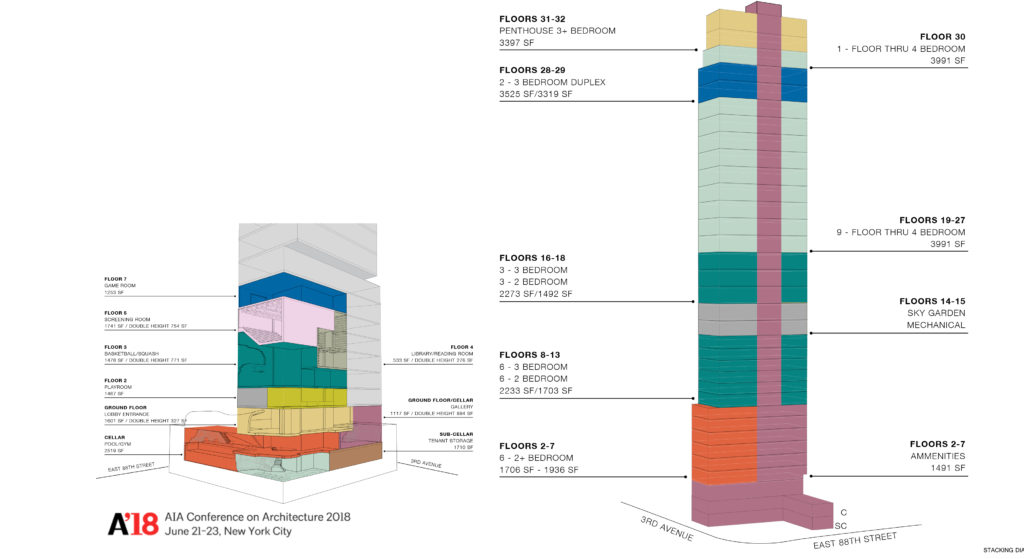
88th Street is a tower that we are doing on the Upper East Side. We do a lot of studies. These are the stacking plans of how many units. It is primarily residential with a commercial component on the first floor. This one was weird. It has this whole amenity package, which turned out to be more or less necessitated by the form and the percentage rules governing that site. It forced us into making all of these amenities. Modeling. We do a lot of 3D modeling.
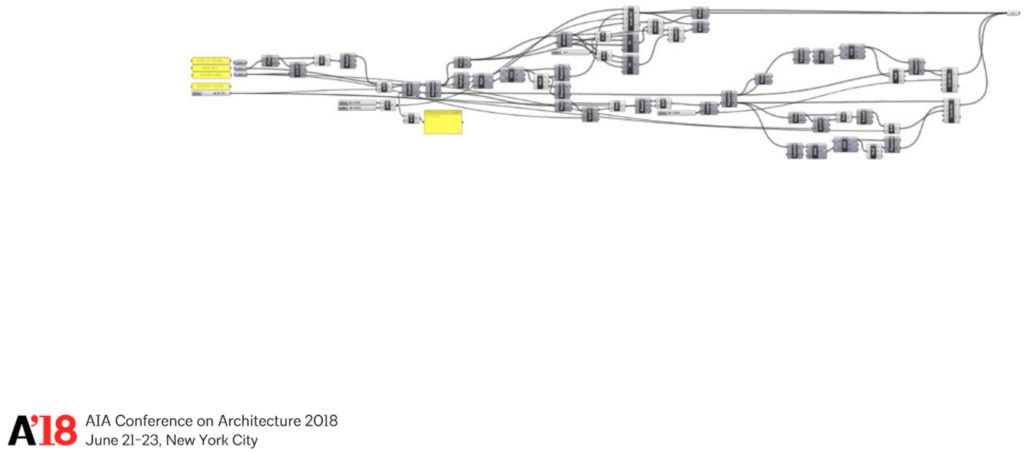
Here is my favorite grasshopper script. That is crazy. I love it. This is the mess of the parameters. Then it results in this, which is actually the fenestration pattern. It literally tied into 10 percent and the different percentages of legal light and air for different rooms. Whether it be secondary bedrooms, bathrooms, or living rooms.
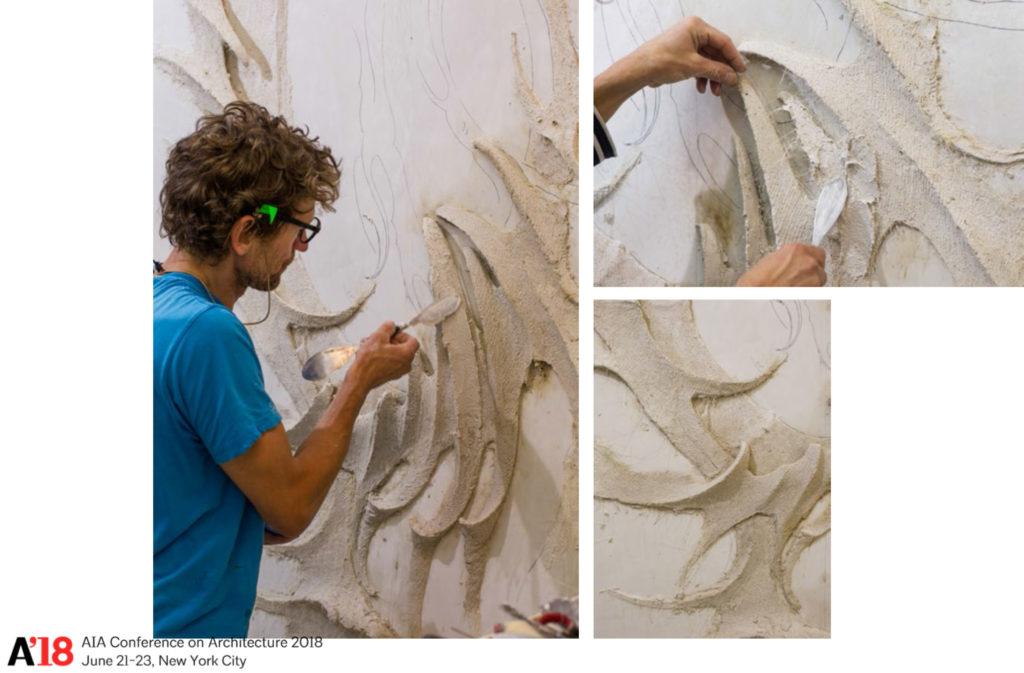
This is our brick mock-up. This is our artisan Jan Hooss, working in stucco. We like to go macro to micro and find that these very micro collaborations work their way back into the macro. These are the arches in the top of the building. We are currently on the 28th floor, and there are 31 floors. So we’re getting close. Brick started.

Just leaving you with this last slide of the sales gallery. This is Stephen Quinn on the right, who wrote the book on dioramas. He is the foremost diorama authority. He works with the Museum of Natural History. When you go to the Museum of Natural History, he has a book in there. It’s fantastic. We needed to make windows in the sales gallery. Many people are offering these digital prints. We said, “Nah, that’s crazy. Let’s talk to the folks at the Museum of Natural History.” Sure enough, they were really interested in partnering with us and we made this diorama of Central Park. For me, it is that touchstone of just asking a question, “Can you do this a little differently?” If you approach it with some great people and some passion and energy, some fun things can happen. Thank you.
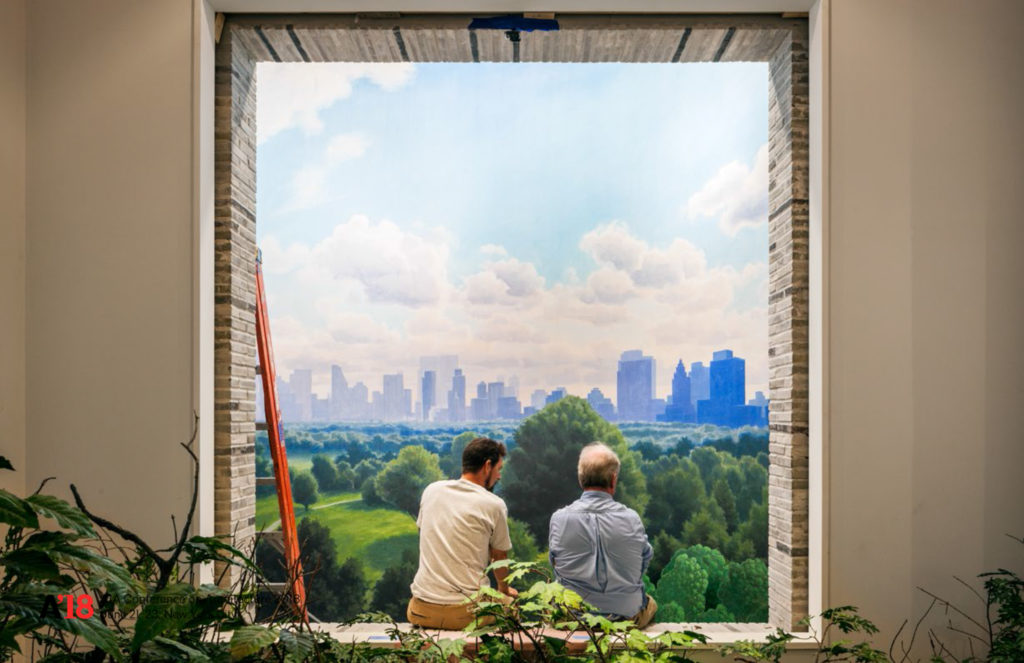
James Petty – Architect & Developer
I just wanted to talk about a few things real quick. What these guys are doing isn’t new. I know that the AIA hasn’t talked about it for a very long time, but in 1777, John Nash took a lease assignment on a piece of property in London and developed 8 units. That was 241 years ago. He later designed the Royal Pavilion in Brighton and Buckingham Palace. That is what you probably know him best for.

So how do you do this? I want to break this down into a couple of quick steps for somebody who is an architect trying to get into the development.

The first step is that you’ve got to educate yourself. You need to take the time to learn a lot. There is a lot of terms that you need to know: the NOI, the ROI, the NPV, the IRR, etc., etc. You can get a real estate degree, but there are a lot of universities who are starting to put more of their content online for absolutely free. Coursera, EdX, and iTunesU are fantastic resources [more info here]. They may sometimes look like they are behind a paywall, but if you work your way through it, it is free. The Real Estate Finance course by GSAPP is really one of the greatest things to start out on. Pro formas. You need to learn how to read them. You need to learn how to take them apart and put them back together. But really, it is a simple process. You buy it for X, you put in Y, and you get out Z in the end, but you need to understand what that process is.

Real estate is a debt-financed industry. If you have student debt, you need to get it refinanced. If you have bad credit, you need to get it fixed. You need to put yourself into a situation that when you go to an investor or a bank, they see you favorably and they will give you money. You also need to start putting money together. You are going to have upfront cost for land acquisition, consultants, and entitlements before you will ever pull a construction loan or get an investor to put money into your product.
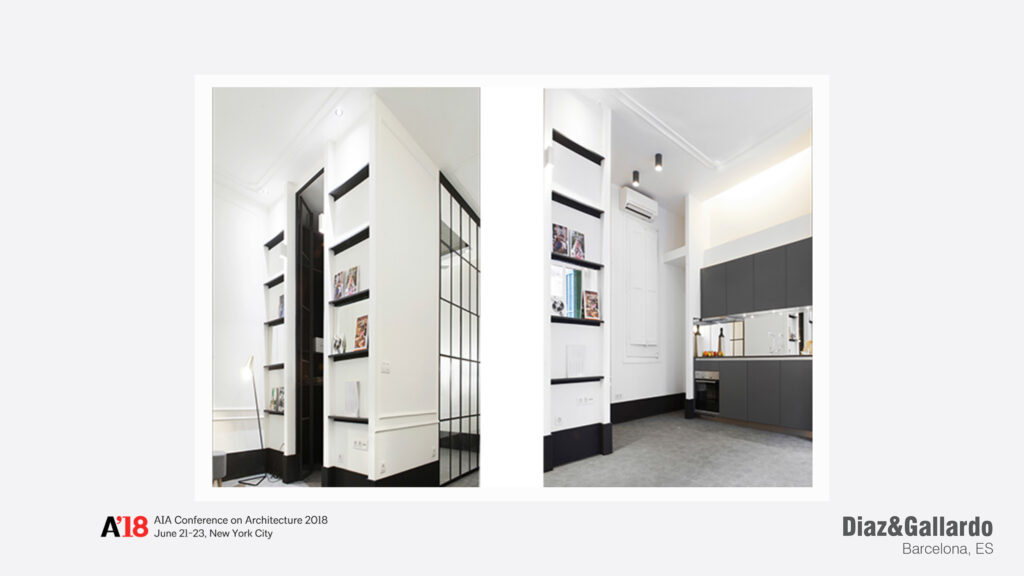
You need to figure out what you want to do. These guys [Alex Barrett, Jared Della Valle, and Peter Guthrie] are doing big projects that cost a lot of money, but a lot of people are starting out in smaller ways. Diaz & Gallardo is a couple in Barcelona who lost all of their clients in 2008. They started buying small apartments and renovating them themselves. Now, they’ve decided that they don’t want clients anymore and they keep doing this. They’ve done over a dozen.
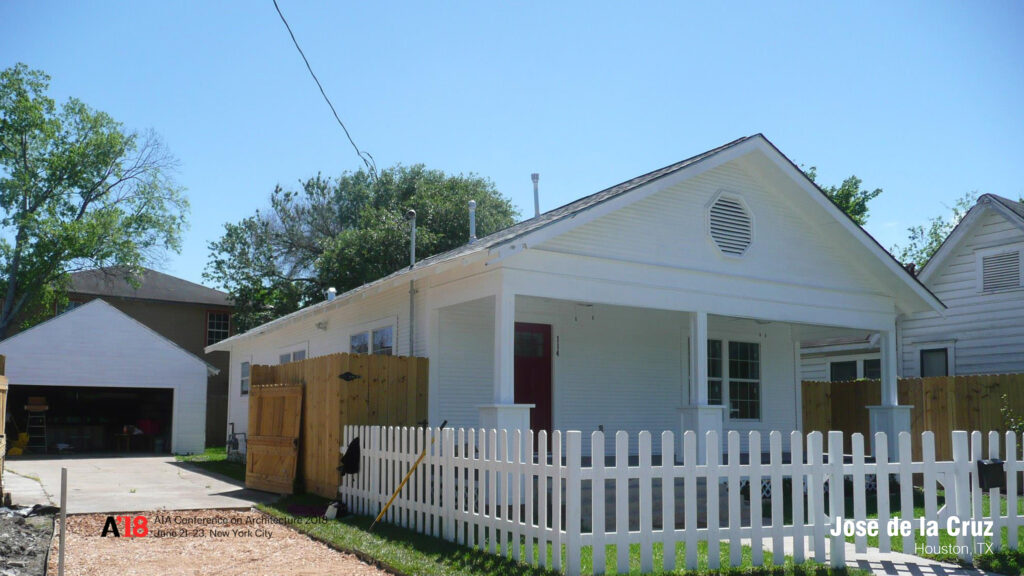
Jose de la Cruz borrowed money from his brother and his 401k. He bought a house for $80,000, put $80,000 into it, and sold it for $280,000. All while working a full-time job at an architecture firm. So his day-job Monday through Friday. He worked on this house Saturday and Sunday, and he still doubled his money on this guy. He is working on his next one now.

You can do a new build. Mike Benkert also has a full-time job. On the side, he bought a $25,000 lot at a sheriff’s sale. He works nine-to-five, and on his lunch breaks, he checks on his contractor building his project. This is his second house and he’s getting ready for that third project. It is important for him to keep his day job for the financing. Banks need to know that they are going to get their money.
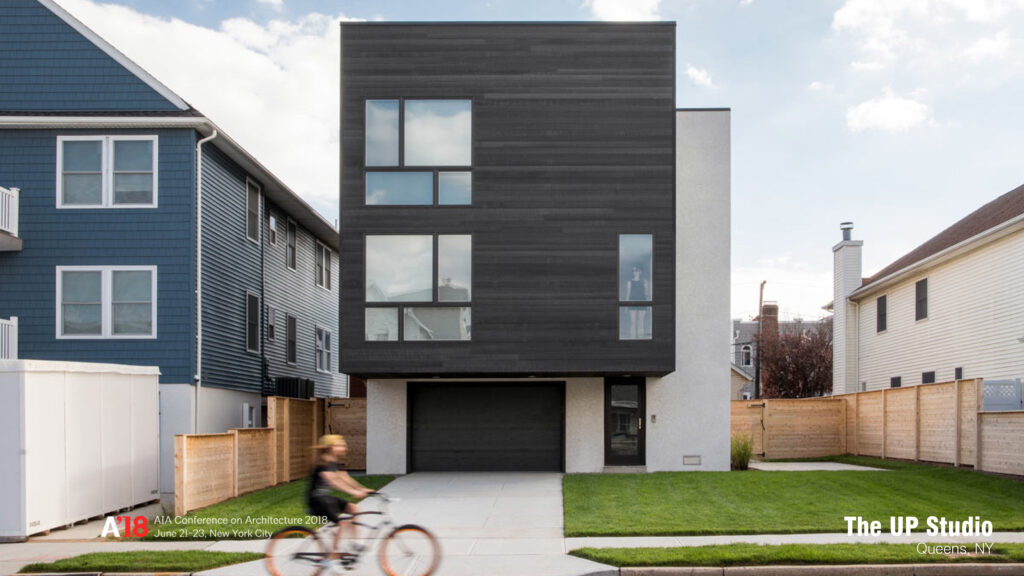
This is The UP Studio here in New York City. They are a young couple of guys doing a lot of interior work. They wanted to do a modern house. Nobody was hiring them to design a modern house. So they bought a piece of land and did it themselves. While it was under construction, they had several people walk by. They said, “I love your house. I’d love to hire you as my architect.” Now they have several projects. They are making legitimate buildings and they are on to their second development.

Multi-family is tough. What these guys [Alex, Jared, and Peter] are doing requires a track record and to be heavily capitalized. This is Cary Tamarkin. He has a lot of projects on the High Line. They’re beautiful. Like I said earlier, if you go to bit.ly/archdev, you can download a map onto your phone, and you would be surprised by how many buildings are actually developed by architects.
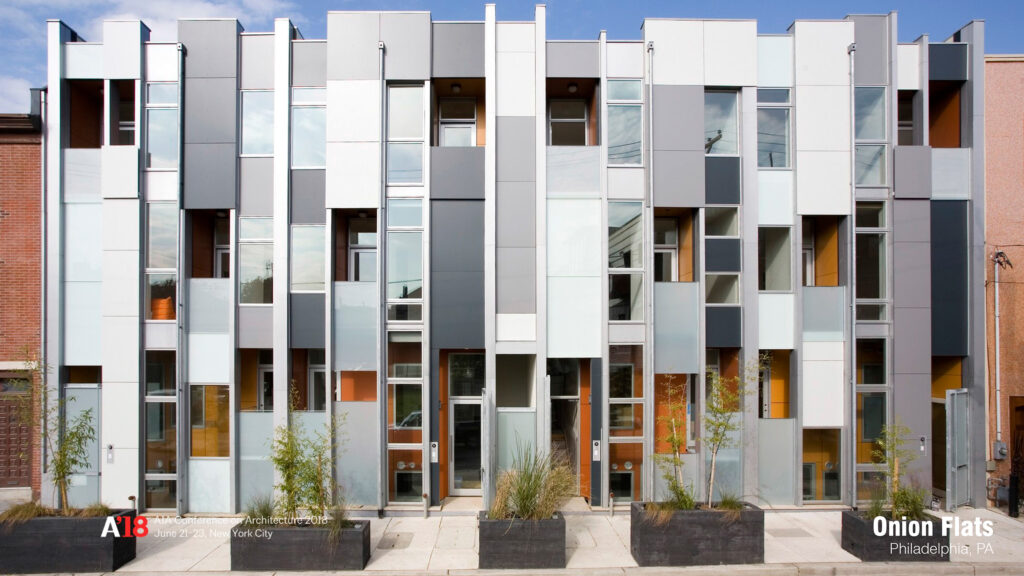
With multi-family units, pre-selling is a really big deal. This is a great example of where you can be clever. To be an Architect & Developer, you need to set up a lot of entities and a lot of contracts between yourself. Onion Flats was able to get the

You can also play with your own academic ideas. This is Jonathan Tate down in New Orleans. He started with this little sliver house on the right, which has been getting a lot of press lately [see here]. While that was under construction, which he developed, he bought the land all next to it. Zoning gave him the right to do three single-family houses. He didn’t want to do three-single family houses. He was interested in a tighter, denser neighborhood in New Orleans.
So he created a co-op on the land which allowed him to create ten detached units. It created a really interested little network in what he calls Starter Home*. It is an academic exercise for him that has also become lucrative.

In downtown San Diego, there are these three guys [RAD LAB] who had a thesis project to create an urban park. They wanted to create it with no money… because they were in grad school. So they raised $60,000 in a Kickstarter to pay for a bunch of up-front fees. They went to the mayor’s oce. They said, “Look, we were able to raise a bunch of money, can we get something from the city.” So the city pitched in. They gave them a 2-year lease for cheap on land that was later to be developed. Then they got some investors. They got each one of these tenants to sign up. They made the tenant pre-buy their shipping container and pay RAD LAB to design the thing. So RAD LAB was off to the races without much money. Now, each of these tenants pays RAD LAB rent each month.
So this is great. What these guys [Alex, Jared, and Peter] showed you was great, but then there is the real reality of the situation, right? [I am an architect. I have no money] So, how do you figure out your financing? The truth in real estate is that nobody has any money. It is always other people’s money.
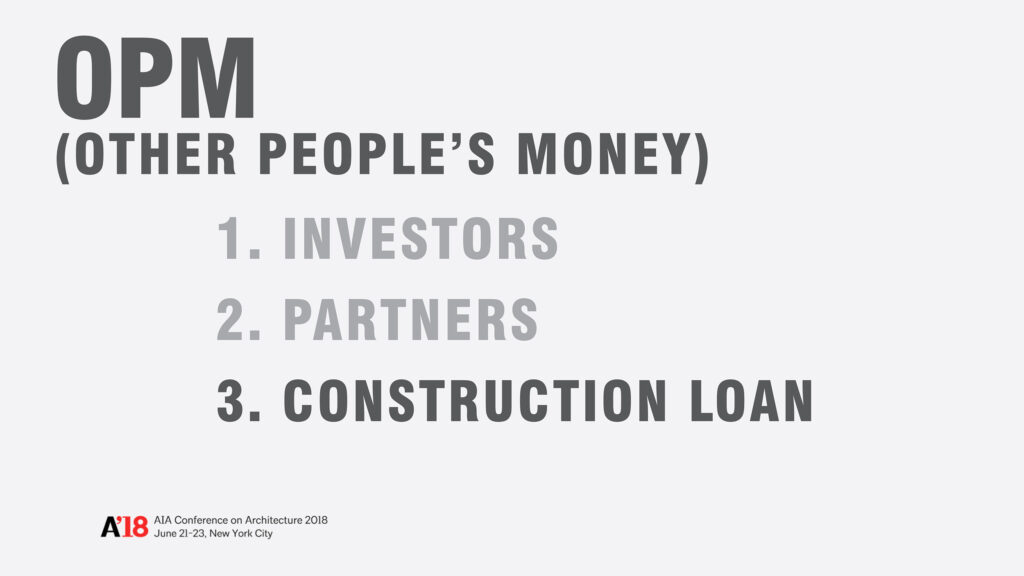
You need to find investors. Maybe that structure is something along the lines of offering a 10 percent preferred return and split the profits 50/50 afterwards. Maybe you get a partner where someone else comes in and puts in all of the money while you put in all of the work. In the end, maybe you get some money out of it. Or you get a construction loan, which might have terms of 4 to 6 percent interest (although that is getting higher these days). They will give you up to 70 percent of the cost of construction. They aren’t going to give you all of what you need, which means there is still going to be a gap in what you need. That can be problematic, because you still have to ll in that 30 percent gap
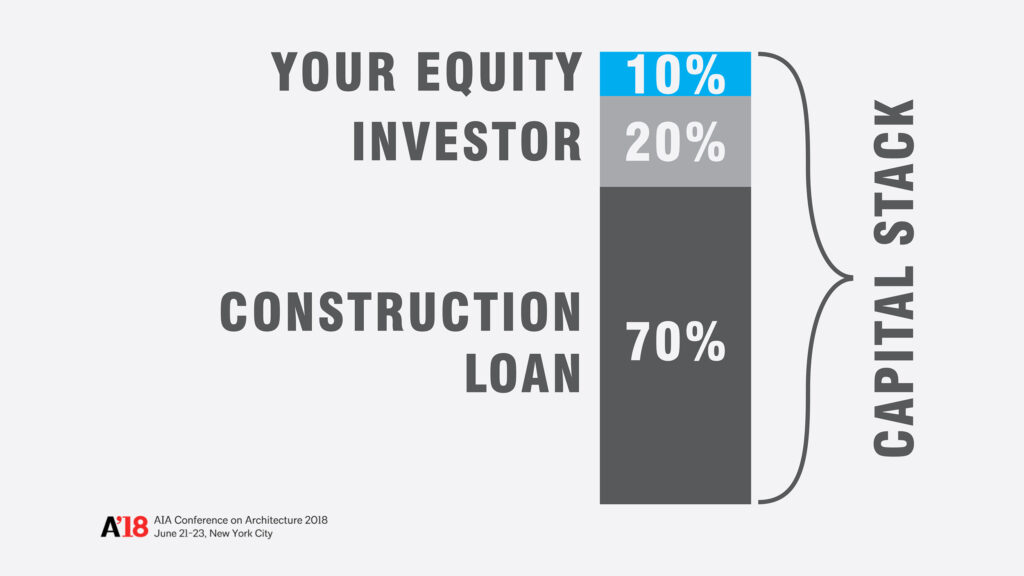
This is where you get creative. You use your skills to create what is called the capital stack. There are a lot of ways to do this, but this is just one way. You get a construction loan, find an investor to bridge the gap… which is a loan on a loan… the risk is higher… but you decrease your equity to 10 percent. This is a very real scenario of how people develop real buildings. But how can you get that equity even lower? I have a few little thoughts on that which I want to share with you today.
One of which is architecture is equity. When you have all of these diferent entities, and they [Alex, Jared, and Peter] talked about that before, you can use your fees as an architect that are early on towards your position in the loan. Banks will recognize that, so long as you create a paper trail. Contracts with yourself. “Money Days” like Jared was talking about.
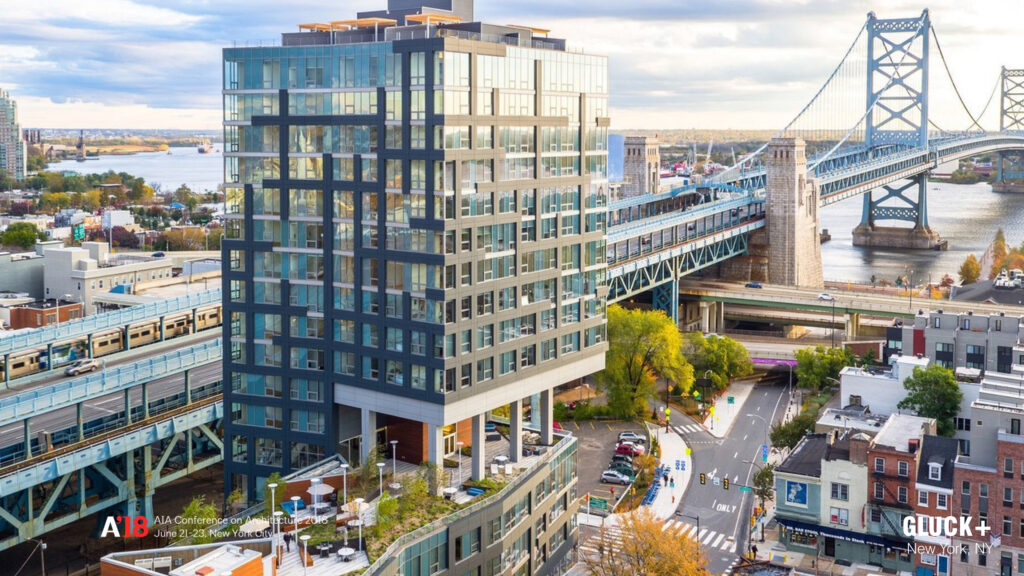
Another idea if you want to take a little bit less risk is that if you have an existing relationship with a developer, you can do what GLUCK+ did. We put in sweat equity into the front end of this project. Basically, the architects worked for no fee for a percent stake in the ownership of the project. This is a rental project in Philadelphia. Now GLUCK+ takes in a percent of the rent every single month. You have to realize that for a developer, all of the fees at the very beginning of a project, which is when an architect does most of their work… before entitlements and before public permissions… is the most at risk for a developer. That is when the architect is most valuable. If you are able to work out that kind of an agreement, it also means that if the project doesn’t go through, you don’t make any money.

Crowdfunding is a very interesting thing that is going on right now. There are a couple of reasons why. This isn’t your Kickstarter. It is a little bit different. There are a lot of projects that you see on Kickstarter that never gets built. So much wasted money. ZUS is an architecture company it Rotterdam who wanted to build a bridge. They raised 100,000 Euros by ofering to CNC route the names of the donors in the walls. The city was like, “Great! People actually want this thing and are willing to put their own money into it.” So the city put the rest of the money up and they built the bridge.
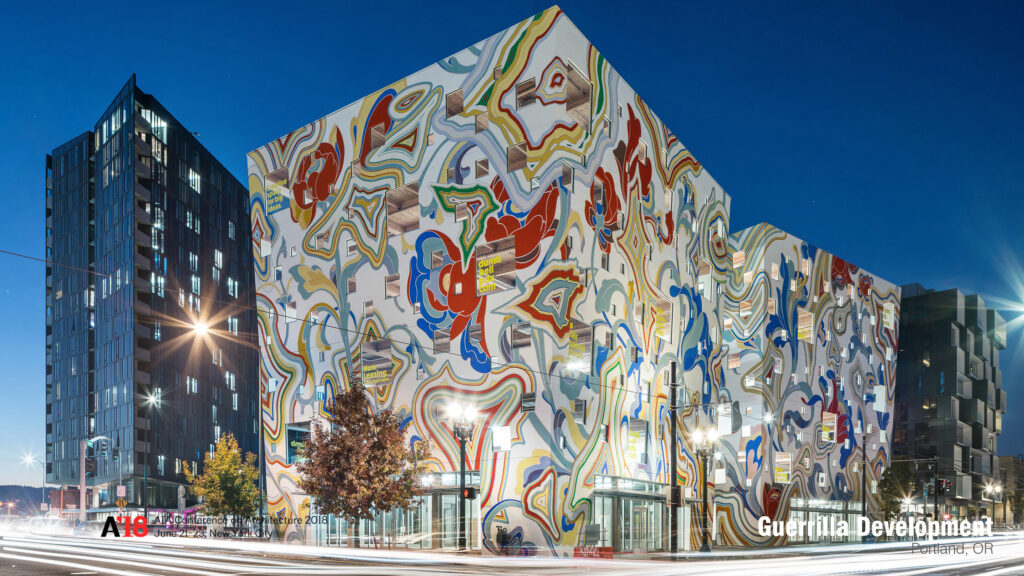
This is the REAL type of crowdfunding that is going to come into play. Before 2012, in order to become an investor in real estate, you needed to be an accredited investor according to the SEC [Securities and Exchange Commission]. This meant that you needed to be worth more than 1 million dollars. Since then, the JOBS Act has been passed. Every single year, that regulation has been coming down to the average person to where a regular person could invest $500 into a project. That is what Kevin Cavenaugh did. This is not a rendering, it is a real building in Portland. He spent 15-months and $200,000 in attorney fees to get SEC approval to be able to crowdfund this thing. But he was able to raise $1.5 million as part of his capital stack. Which is pretty incredible. This project just finished construction a few months ago. In December, he did a second crowdfunding campaign. He was interested to see if investors would take less of a return for a social cause. His next project is housing that subsidizes homeless housing in Portland. He offered investors a 5 percent return, which is very low. Within 3 days, he was able to raise the $300,000 he was looking for which proved his point that people were willing to take less of a return for a social cause. It is pretty interesting.
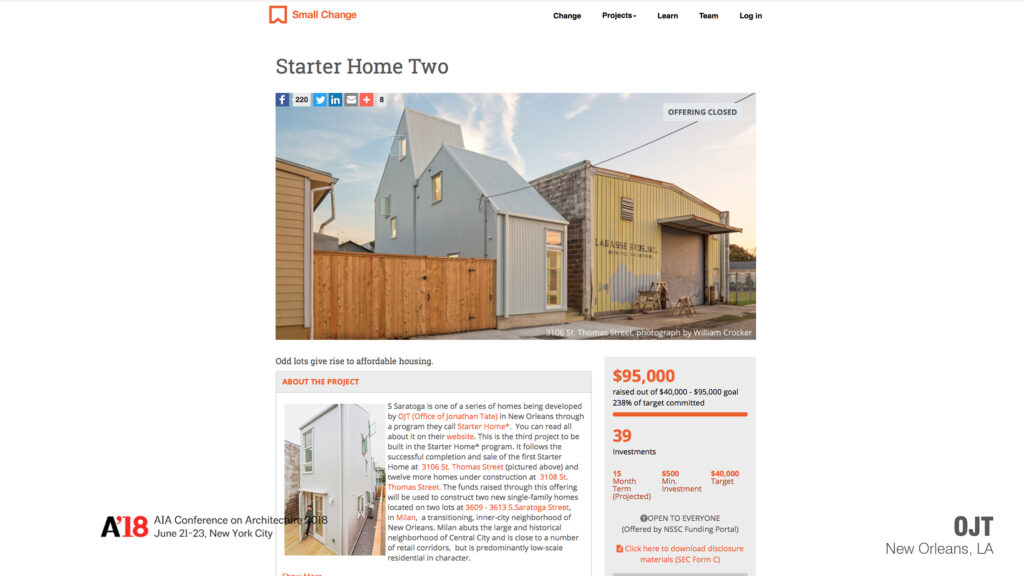
This is the next level. This is regulation CF of the SEC JOBS Act. This is Jonathan Tate again. A few months ago he was looking to raise $95,000 as part of his capital stack. It was $95,000 of crowdfunding, $40,000 of his sweat equity as an architect, and $400,000 of a construction loan. Except instead of having to go to the SEC, he partnered with the website Small Change. It is a website which you can register on. They are already an accredited investor. He didn’t have to do any kind of upfront legal work. He just raised the money and now he is building the building with very little of his own money in it.
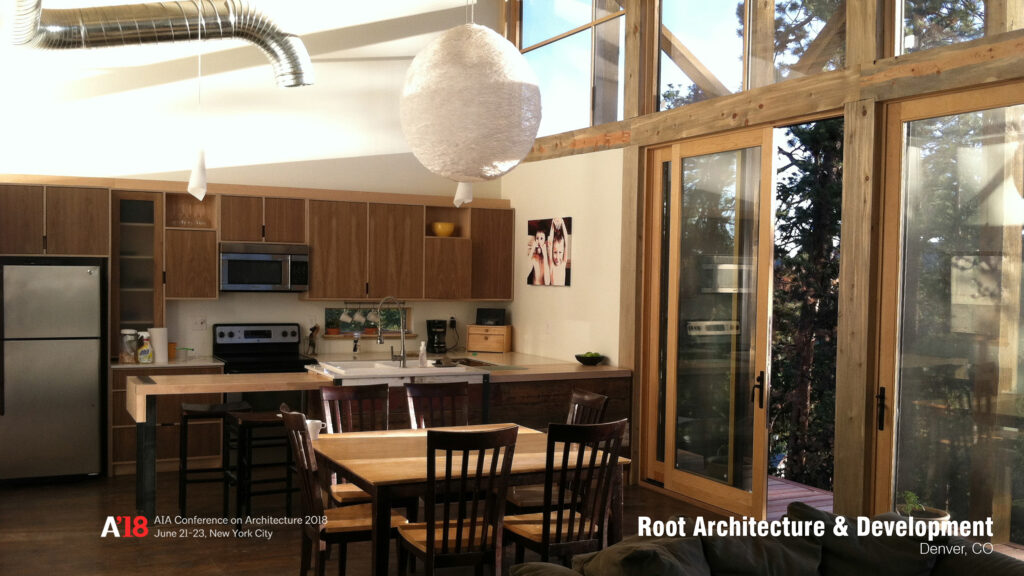
Another program is the FHA [Federal Housing Authority]. Everybody needs somewhere to live. If you are willing to live in your project, you can actually purchase and finance construction of a building with 3.5 percent down. That is what Zeke Freeman did for his very first project in Denver. This is his own house. He got a single loan that was $130,000 for the property and $100,000 for renovation to do whatever he wanted as an architect. It cost him less than $8,000 all in.

The next step is that you need to understand what the market is, what people are buying, what sells, and what people are missing in what they’re selling. The best way to do this is to go figure out what other people are doing through open houses. Sorry, Jared. Forget the AIA tours, one of Jared’s projects is having an open house on Sunday at 3:45 pm. This is all public knowledge. Just go out there and find the buildings that you admire, and go see them! For those of you not from New York City, look at the mortgage. That’s monthly.
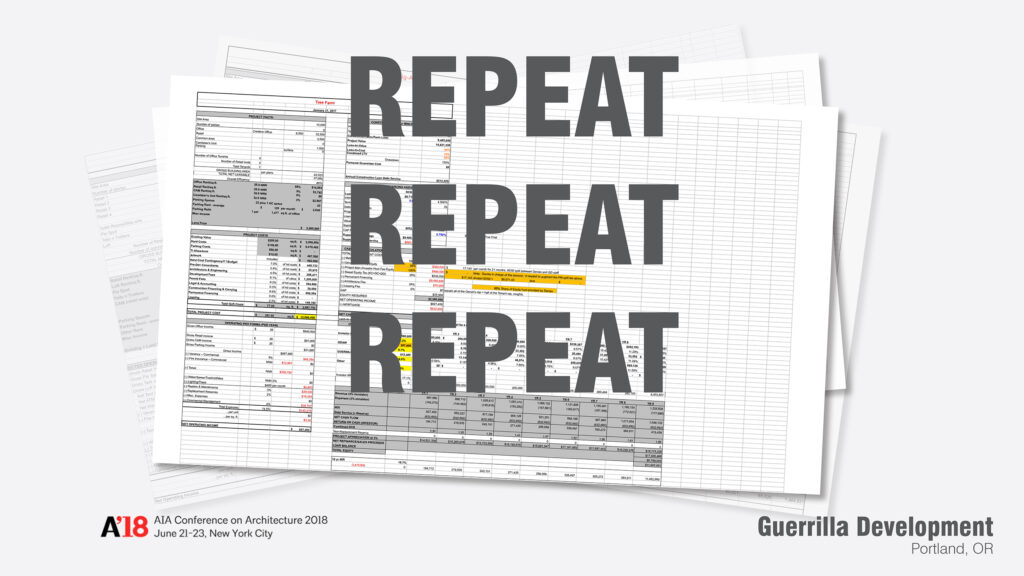
The final step of this process before you get going, is to really try to understand the pro forma. You buy it for X, you put in Y, you sell it for Z. You can download some of these pro formas online, like the ones here form Guerrilla Development [see here]. You need to be able to go through them, take them apart, and put them together. And you need to do it again and again and again. By the time you go to a bank or an investor, you need to prove to them that you know what you are talking about and you know that they are going to get their money back, and they are going to make some money in the process.
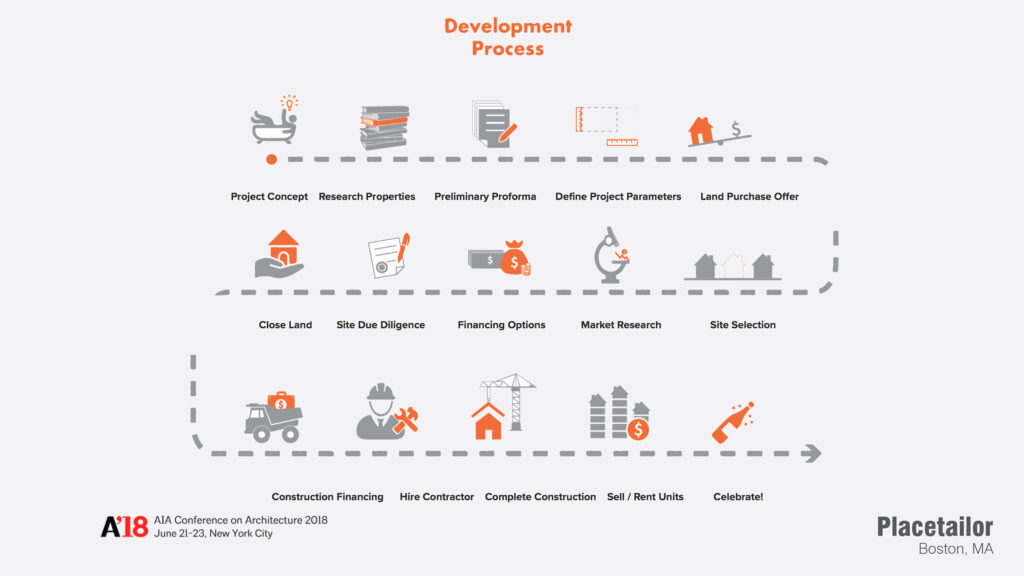
Placetailor put together this diagram. So that’s it! You rip off the bandaid. You figure out what you want to do. You figure out how much it is going to cost. You look up a site. You organize the finances. You close the site. You get a contractor, and you go make money! When you sell, the loan gets paid back, the investor gets paid back, and you get whatever is left in the end… if there’s anything left in the end. Which is a risk.


In September 2017, I sat down with Architect & Developer Zeke Freeman of Root Architecture & Development in Denver, CO. See more information about Zeke at root-ad.com and articles {here}.
Zeke Freeman: We started with a very basic level of development with some house flips and remodels. We also used a 203(k) loan to self-“nance some deals. Then we did our first new home-build. I think architects can be great at this.
In the beginning, it was all about getting funding as a small entrepreneur. The real struggle was financing the deals. You really can’t do it alone. There is this initial mentality that you are going to go in and have a great vision and people are going to want to fund your project. As I was first launching Root Architecture & Development, I thought I would start the business and development at the same time. I was going out and pitching to a lot of investors and trying to get funding without really having a reputation or track record. That was really tough. I got a lot of rejections.
I finally got a few projects through self-financing and one hard-money lender. Through that, I became more involved in design-build. I also earned my GC license. That was the real catalyst that started our company. Suddenly, people started calling and were interested in our design-build work. That grew into custom single-family houses and some multi-family
projects.
As the architecture practice has grown, we have started doing more commercial projects. We partnered with a commercial builder. Our focus has changed a little bit. On the development side, we have a few projects that we are re-examining. Now that we have completed a few projects and we have a real track record, we are now at the point where we can look at more traditional methods of financing.
James Petty: You mentioned that you used a 203(k) loan for one of your projects. Can you talk about that?
ZF: That was what we used for the Indian Hills House. We purchased it for $130,000 and took out around $105,000 to renovate and construct an add-on.
JP: The 203(k) loan is a really interesting product. Since it is an FHA-insured loan, the down payment can be really low. It seems like a really great product to acquire property and have financing to renovate it with low upfront costs.
ZF: Yes, it is an awesome way for an architect to get in and do their own thing. You can do more than one unit too. You can potentially purchase a lot that is zoned for multi-unit and live in one unit while you rent the others. For us, we secured the loan with a 3 percent down payment. Financing can be really challenging, especially coming out of architecture school. If nothing else, it builds a little bit of net worth and real wealth that you’ll need to be able to get the next loan.

JP: Did you use the 203(k) loan to purchase and renovate your own house? Are you guys still living there?
ZF: Yes, once we had equity from our home, we were able to use that property to leverage financing on later projects. What we are working towards now, though, is partnerships. We have a couple of deals that are on the table with clients that are already developing projects. We have conversations of investing our equity into the design and construction of those projects. That is where we are currently looking to go.
JP: That is a sweat equity model. Would you be deferring all of your fees upfront?
ZF: I thought of that term [sweat equity] a lot while we were doing the “x and flips. That involved real sweat too though! We charge a fee for the architecture, and we charge a fee for the construction. But we are going to turn around and put that as equity into the project rather than taking the money now. We are also interested in long-term ownership of rentals. We are even looking at creating something such as an AirBNB building.
JP: That is an interesting idea. Often with multi-unit projects, there is a lot of pushback from people using their property on AirBNB. There should be a market for using a building strictly as a group of AirBNB units. Though I guess that is almost a hotel.
ZF: That is what it falls into. There are a few of these projects now and Denver doesn’t quite know what to do with them. They’re ground-up hotels but they don’t fit into a traditional hotel model with hotel taxes. Those are a little bit tricky. We have a few that we are looking at where we are renovating existing buildings to create executive suites, which are full-floor condos. The building may already be set up as residential use, but we have to change it from something like an R3 to an R1 for the AirBNB model. That change has a lot of accessibility requirements. Then we try to “t it into a hotel model. It is not quite a hotel and not quite a personal residence. We’re trying to figure out what boxes to put everything in.
JP: Is your wife a realtor within your office? Does that mean that on any particular project, you have the opportunity to generate architecture fees, contractor fees, developer fees, and realtor fees as well?
ZF: Yes, however, our main focus is ensuring that we are serving our clients well. We are not trying to do everything, but we are involved in a certain niche and in a certain market. So we have a lot of knowledge in that. Then we look at what the needs of the client are. In the case of building urban infill projects, it starts with finding land first and understanding when you are designing these things what the construction is going to cost and what the market for it is. You have to know what the financial model is. You get di$erent clients coming in at di$erent places. Sometimes we have a client who is a builder and a realtor, all they are looking for is the architecture. Sometimes the client is a money guy, and they need all three pieces:
architecture, construction, and realty. By having those three pieces, it opens up different fee structures that we can bill towards, but also different levels of expertise for our clients. We can speak the language of all the pains that any client will typically deal with.
JP: It sounds like you have an advantage over the standard architecture studio that only designs buildings.
ZF: Absolutely.
JP: Did you take advantage of the in-house realtor for the fix and flips?
ZF: That was why got into it! We were doing these fix and flips and paying realtors as much as we were making. It is always greener on the other side. Having that now and working closely with my wife on the real estate side, we value that a lot more than we thought we were going to. There is a lot of work that goes into getting to that sale point. There is a ton of marketing and lead follow-ups.
JP: Was she already into real estate before you guys worked on the fix and flips?
ZF: No. She got into real estate because of the fees that we were paying. We were like, “Forget this. We will just do it ourselves.” That is our typical mentality. She is doing well with it. At first, we thought it was going to be a piece of cake. But like everything else, there are no shortcuts. There are fees for a reason. It is the same on the construction side. As an architect, you are looking at the construction fees that may be two times what we are charging as an architect. I spent seven years in school to get licensed and afterward did all sorts of construction things such as a framer and being a GC. But there is a lot more risk that happens in construction. The biggest aspect of construction is how much risk are you willing to take on, and how much can you manage that risk? All of a sudden, you are liable. If the drywall guy makes a mistake, you have to be the guy to step-up to the plate and take care of it.
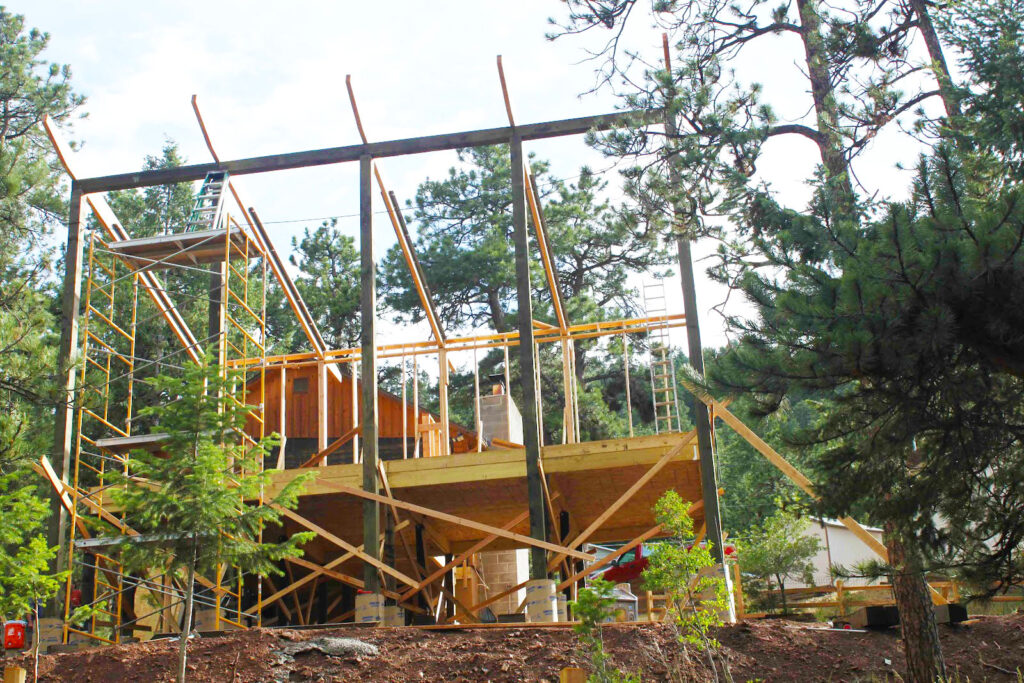
JP: What led you to the architect-led design-build (ALDB) model?
ZF: It was all out of frustration and pain. We got into real estate because of the frustration and pain. The construction side is the same thing. As an architect, you try to push the quality of design and make great spaces. There is that innate battle that is set up between the architect and the contractor. You are going to push something great out there and you’re going to get it pushed back for whatever may or may not be the budget. But you never really know what is behind that shady curtain of what things really cost. We wanted to unveil that and add clarity to the process.
JP: You can also gain a lot of effciency with ALDB. You no longer spend hundreds of hours answering RFI’s and processing submittals. As one design-build entity, you don’t waste all the time used for coordination that is required when a project has a separate architect and contractor.
ZF: Yes and you are also charging more fees. It is a lot more expensive to run a construction site, but it is more effcient in terms of communication. It takes a little bit of that pointing fingers away. You are no longer in that position of pointing at the contractor for making a mistake or pointing at the contractor for destroying the design. You are it! You are taking that responsibility on. There are risks and rewards with that. We are all sitting together at the table as a team. We are trying to make the best project that we can with the budget we have to work with. What construction really takes today is constant communication. There may be a detail where with a typical design-bid scenario it gets missed. Then the contractor decides to do it on his own. Nine times out of ten, he does it wrong. If you are designing and building while in constant communication with your team, you can pick those things up. We have daily huddles and weekly meetings to review how we are handling everything going on. We hang out on the job site and sketch out details in real time. It really brings a level of communication that is really needed today.
JP: Did you get your general contractor (GC) license after the fix and flips?
ZF: Yes, we were doing our own development, so I obtained it for that. Then some of the developers that we were doing design work for started asking us to manage the construction too.
JP: How many development projects have you guys completed?
ZF: I did about four or five projects that were either fix and flips or custom single-family residential. I have really focused the last four or five years on the architecture and construction side of things though. Going through the pains of trying to get investment capital is a whole other skill set. You have to be at a financial point where you can take a lot of risks. A lot of hard money loans require you to put all of your personal assets on the line while paying high interest. That is one entry mark. The 203(k) loan is another entry mark. I felt like that was a better entry in terms of financing. I felt like we could use that to build up relationships and a portfolio. At least then we weren’t coming to the table empty-handed for the next project. It is better than showing up and being like, “Well, it is our first time to do a project. We would like to develop it. Would you fund it?” That doesn’t work. Now that we have done a number of projects, we are in a better spot. If you want a turnkey solution, we have the subs lined up. So we are starting to dip our toe back in. Come back to us in a year or two and we should have something really interesting.
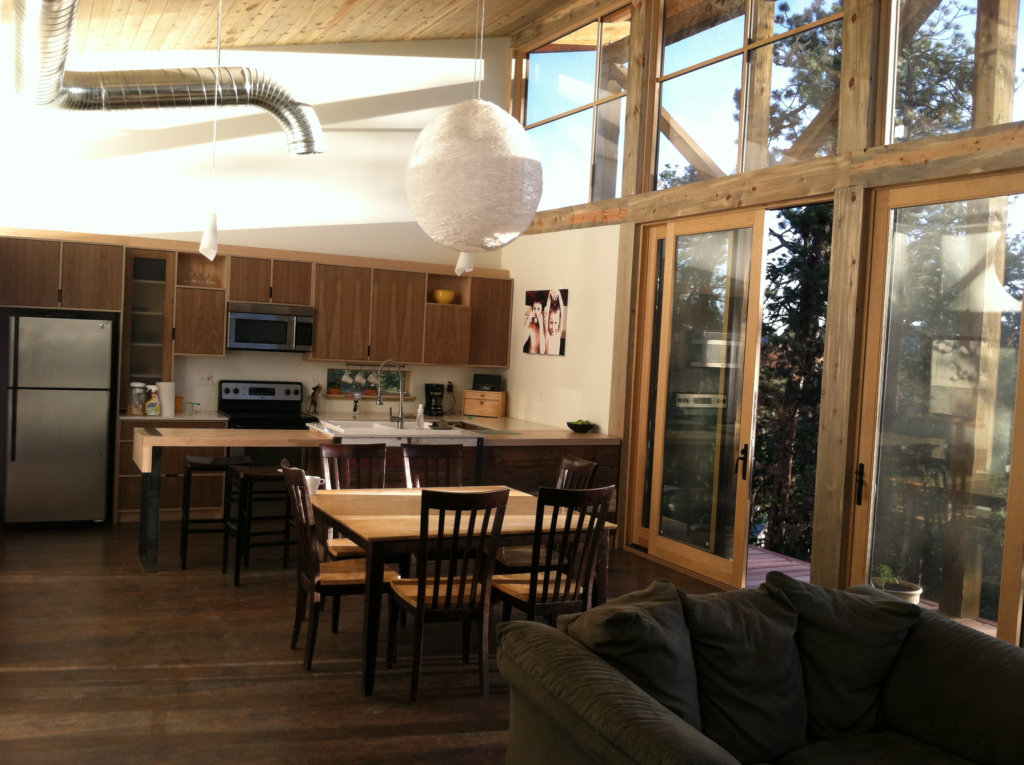
JP: So you think that the optimal model right now is to “nd someone who is already a developer and partner with them?
ZF: It is a way. You have to use your assets. If you are born with a trust fund and a lot of family money, go for it. There is no shame in that. Do a project with your family money on the first one. If you are bootstrapping like the rest of us, you need to try something different. The key is to try something. You have to do something. We made a little money doing the fix and flips. For us, that was our best entry point. The next entry point is really finding your specialty, which comes with building a firm and experience and then leveraging the asset of that knowledge. Then you’ll be in a position to really be able to know how money is made. There are a lot of guys with investment money out there. They want to put it into a solid space. It is about lowering their risk and being the guy that can do that for them.
JP: It is about instilling confidence in what you are capable of?
ZF: Right. Rather than just pitching something that seems like a good idea, you can come in and say, “We have done 10 of these and this is how they perform. We got our hands dirty in terms of understanding a return on investment. We understand costs and realistic time periods.” Then you can create a pro forma that is not guesswork. It is based on actual projects and actual performance. If you have done that with clients, they can sometimes be the easiest investors to go through. Just like the realty side and the construction side, the development side is not a cakewalk. Those guys are doing a lot of work and earning a piece of the pie. They are often glad to hand over the management of that development portion into capable hands and be a passive investor. They worked their way up the scale just like we did in architecture. Being a developer is not the top of the food chain. The real top of the food chain is when you are only putting the money in. You can leverage yourself by taking on some of that role that a developer usually plays. There are so many di$erent people in di$erent places in the chain.
For more on Zeke Freeman, click {here} and also see the book Architect & Developer: A Guide to Self-Initiating Projects.
]]>Enoch Sears at the Business of Architecture podcast recently interviewed Architect & Developer Zeke Freeman of Root Architecture + Development in Denver, CO. Listen to the two-part podcast, see show notes, and see Zeke’s pro formas at businessofarchitecture.com. See more about Root Architecture + Development at root-ad.com.
You know, building your own home is one of the really easier things to get into. It’s very difcult to do and get done and fit into a full life of a job, and kids, and a career, and all those things, but it is one of those things that’s financially accessible – there’s an FHA loan, there’s a 203k. The great thing about that is they’ll let you know borrow as much construction cost as you want as long as your income can support it, so there’s no after repair value ratio or anything that they look at.
-Zeke Freeman
When you’re developing a project, it takes cash, experience, and then trust with your network of people that you can get it done. By developing your own house, you can actually get a little bit of cash, which is one of the key things to do. We haven’t sold this house that we’re in yet. We’ve fixed and flipped some other houses up to this point, but we add a little equity into that. That helps now to take out other loans. So, it is key and is helpful, I think, both in cash and in experience, and then also building that network.
– Zeke Freeman
Discover more podcasts on the Architect & Developer Podcasts page.
]]>